
Rights Reserved - Free Access.
This digital object is protected by copyright and/or related rights. This digital object is accessible without charge, but its use is subject to written permission.
Unless expressly stated otherwise in the licensing conditions, you are free to make any of the acts permitted by your national copyright and related rights act, including browsing, printing and making a copy for your own personal purposes.
All other acts of reproduction and communication to the public are subject to the licensing conditions attached to the digital object.
ARMY BOOTS OF THE WORLD. REVIEWS
Important notice: we do not sell any boots! The prices are given for information purposes only!
France ![]()
"Pataugas" - canvas and rubber boots of the French army ("Pataugas" - les chaussures de brousse de l'armée française)

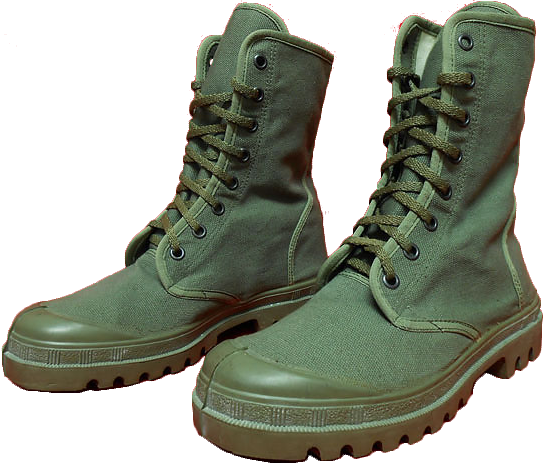
The first model of lightweight rubber-soled canvas boots intended for use in the jungles of the Pacific theater of operations was developed by the US military in 1942, during the Second World War, and got the name M-1942 (or simply M-42). However, until the end of the war, this model was not wide-spread. Moreover, in 1945 a more convenient and perfect boots model 1945 was created.
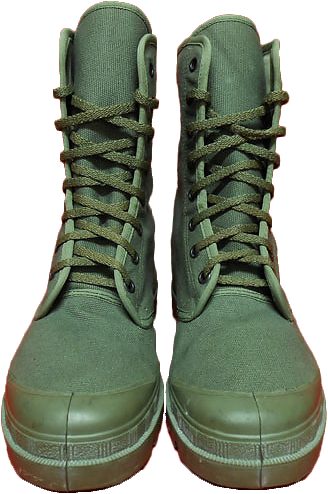
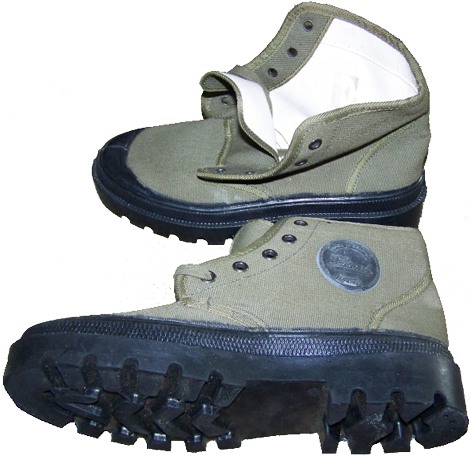
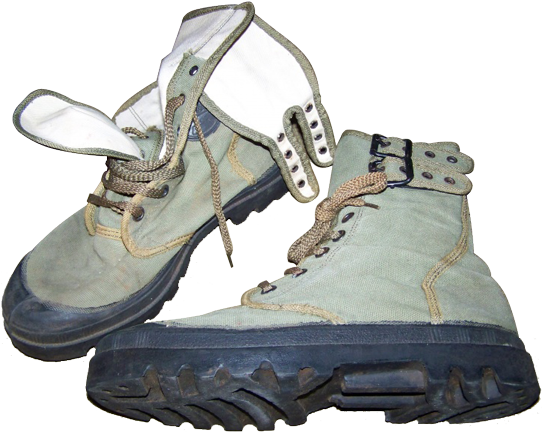
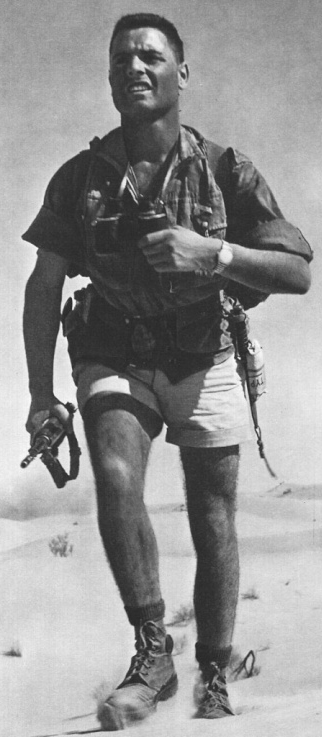
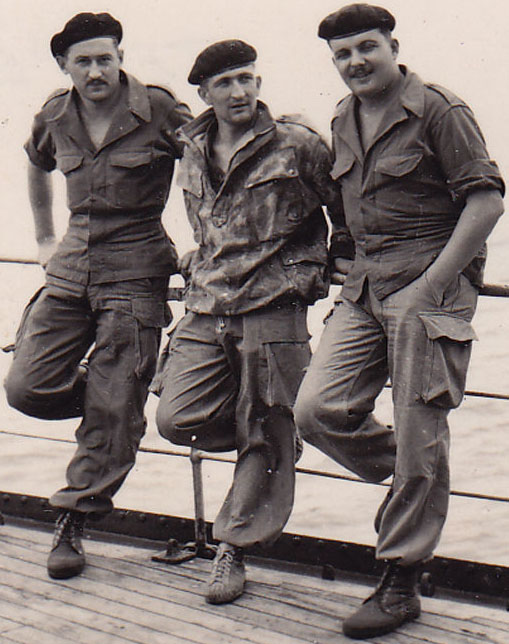
At that time the French troops in the Far East, which were very busy with post-war reconstruction of their former colonial influence in Indochina, still had no similar footwear for tropical climates. In 1948, France began developing the concept of its own canvas boots with rubber soles and its detailed specification.
By request of the French Intendance (Quartermaster Service) in the Far East (l'Intendance en Extrême Orient) in the early 1950s the first model of canvas boots with rubber soles for use in hot climates ("Chaussures de brousse", literally "boots for the bush") was created.
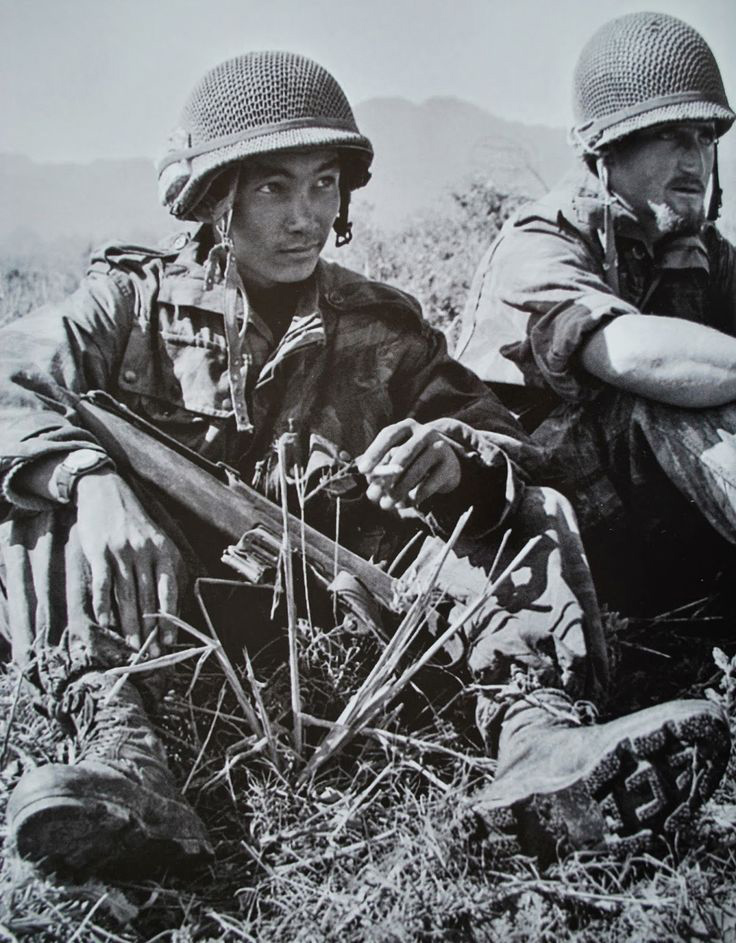
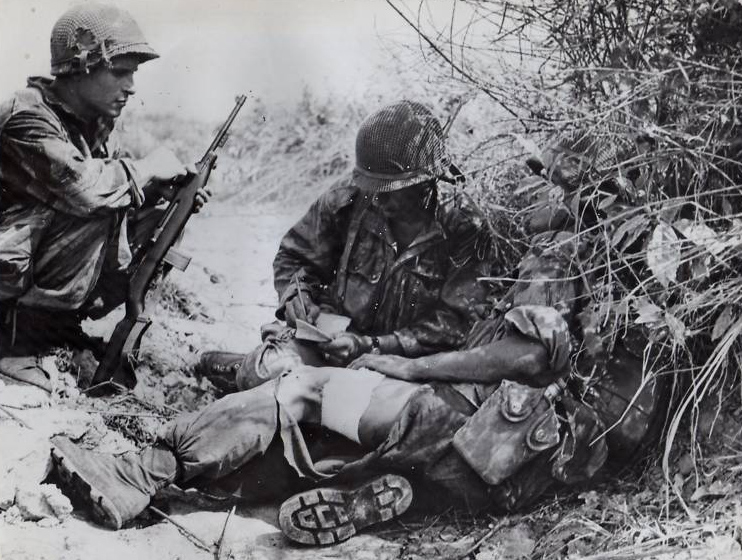
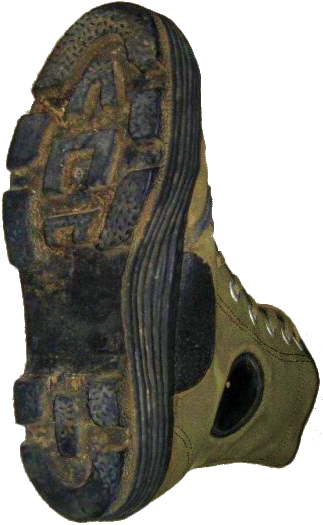
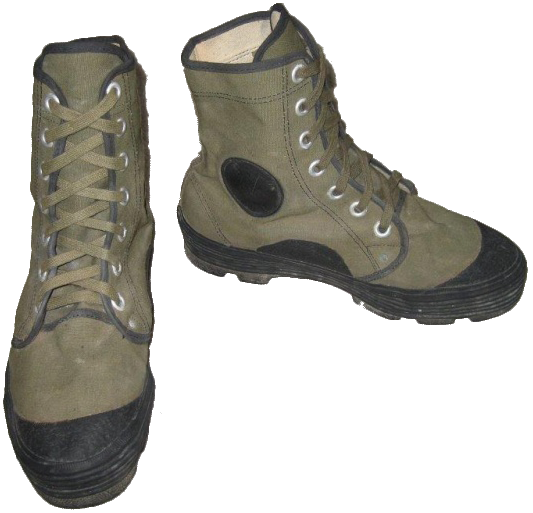
These early boots were dark olive-green in color, they featured structural seams covered by stitched black cotton ribbons, black cotton bootlaces were threaded into aluminum eyelets, and the black rubber out-sole was relatively thin and stinky, spreading strong rubber odor around.
The construction of the boot's top was reinforced by metal rivets at the base of the lacing system. Further on this early model was widely used in the beginning of the war in Algeria. By 1952, there were several modifications to such boots, and they used to be manufactured both by military industry factories and by private producers (contractors of the Defense Ministry of France). The main requirement was the ability to fulfill the requirements for materials and quality established by the military specification.
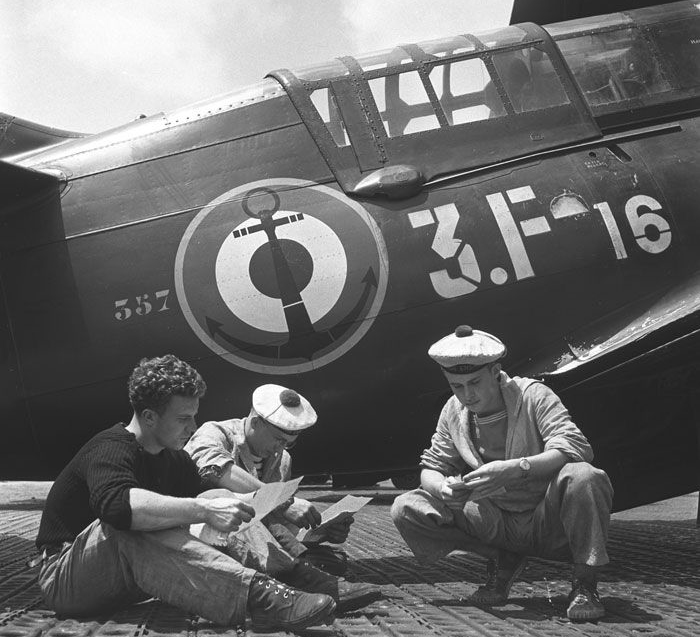
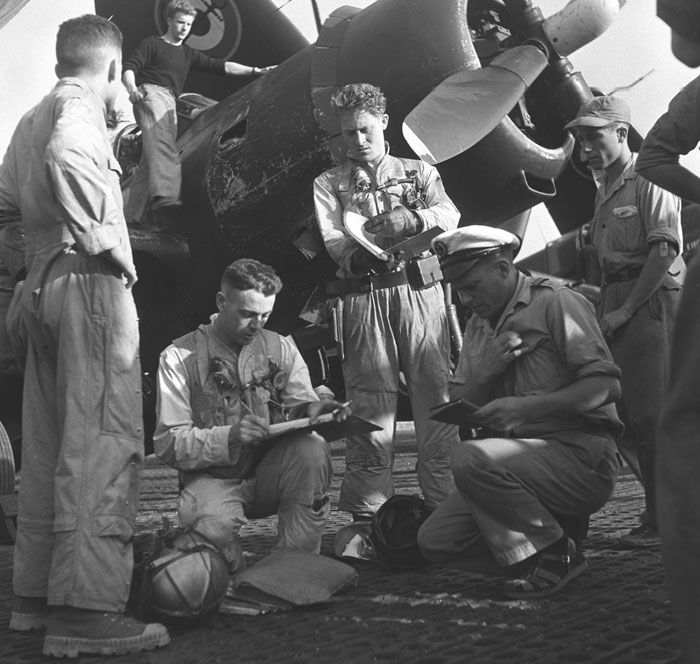
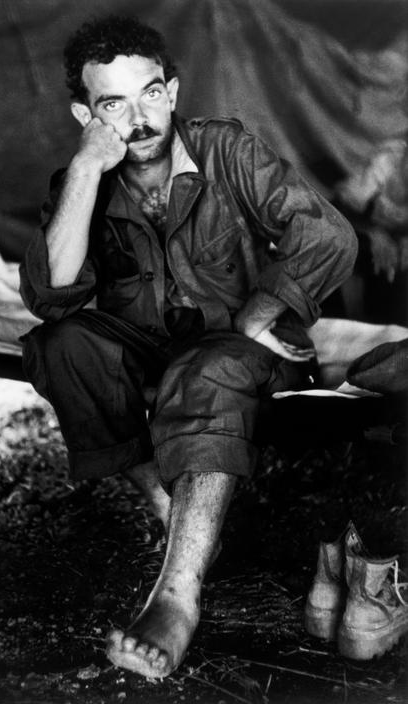
Talking about more recent documents (since the year 1958) it is worth mentioning the technical specification of the France Ministry of Defense "Tenues tropicales et modèles spéciaux aux troupes d'outremer" ("Tropical uniforms and special models for the troops operating abroad"), with its six pages detailed description of the appearance and the materials to be used in the production of canvas and rubber boots.
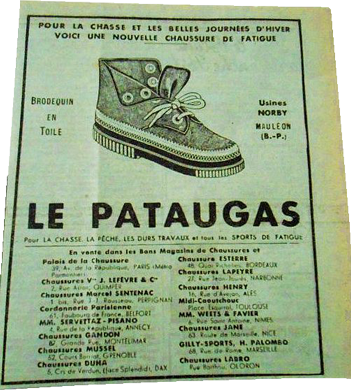
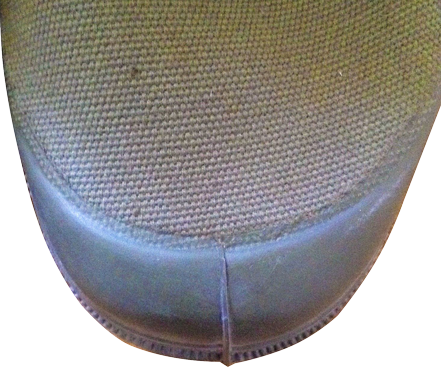
The French canvas boots with rubber soles got the original name "Pataugas". This term is derived from the French phrase "Pat au gas" (namely "pâte au gaz", that is "rubber processing by gas"), which, in turn, gave the name to the company that first developed the production process for this type of footwear.
Canvas boots with rubber soles "Pataugas" were created on August 24, 1950 by René Elissabide, a French inventor of Basque origin, whose name can be translated from the Basque language as "the path to the church" ("le chemin de l'église" in French). He lived in the small town of Mauléon-Soule, the capital of the smallest of the seven Basque provinces, located at the foot of the Pyrenees. There, in really makeshift conditions, he conducted his experiments by heating the rubber paste on a gas stove to connect it with the canvas top of the lightweight boots (literally: "Sur une chaussure en toile montante, il applique une semelle crantée, obtenue en faisant fondre de la pâte de caoutchouc grâce à un réchaud à gaz, de la "pâte au gaz").
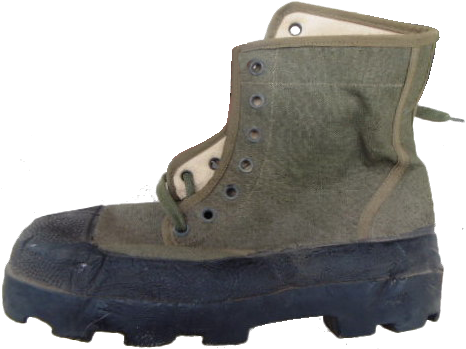
The idea of such a footwear came to Rene back in 1930s, when in a small village somewhere in the valley of Roncal he saw Spanish children making a semblance of traditional local boots "abarcas" from old car tires fixed on the legs with ropes. This scenes were not uncommon in Spain, which was destroyed after the Civil War of second half of 1930s.
At that time, he created and perfected the rubber processing technology, and called it "Giraudier" ("d'un technicien du caoutchouc dénommé Giraudier"), in the result of which he managed to create "Règum"-type footwear, a simplified prototype of the future "Pataugas" - more simple canvas boots with rubber soles, and he used to put the marking of his initials - "RE" + "gum" (the sole material).
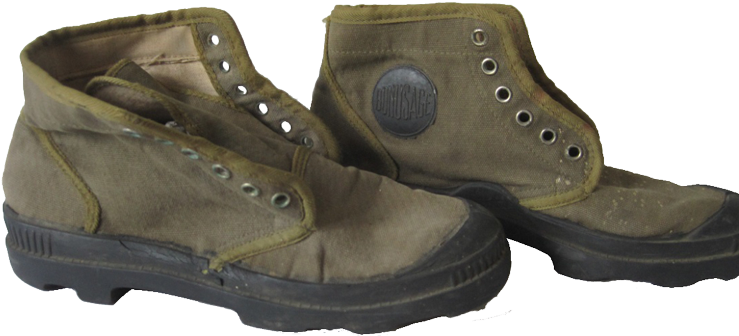
René came back to the idea of lightweight canvas boots with rubber soles after the war, in 1948, when he returned from a trip to the United States. He thought out the details of some lightweight, but sturdy boots, suitable for intensive use in the field. Within the first two years there have been produced the very early prototype models of "Pataugas", which are widely known nowadays throughout the whole world. An interesting fact: "Pataugex" and "Patagom", the early trial versions of the name "Pataugas" failed to survive and were rejected, so nowadays almost nobody remembers them.
René came up with quite a witty slogan for those early models of "Pataugas": "Je n'évite pas les flaques. Je les cherche!" (fr. For "I never pass round the puddles, I'm looking for them!").
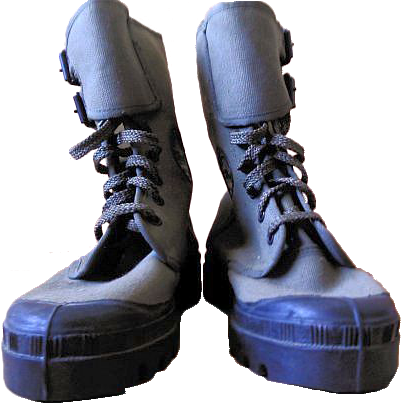
The success was immediate and impressive! If in 1949 there were only 10 workers on the René's factory, by the middle of 1950s the number of workers was multiplied by 40 times! Every day, the factory produced over 4,000 pairs of boots, and on the small station Maulèon this cargo was loaded into 2-3 wagons for further shipment to customers. It seemed that nothing can disrupt the production process, but on September 7, 1950, a fire almost burned the factory down. However, only fifteen days later, the factory was working again. Renè's talent as a manager can be proved by the following fact: during the general strike of the year 1952, for almost two months France was literally paralyzed (almost all the enterprises in the country stopped working), and only "Pataugas" factory continued manufacturing, as the working conditions and wages were very good. And the factory has proven its ability to fulfill the orders on time, especially for the French armed forces, which entered into a contract for the supply of footwear for the French soldiers and legionnaires sent to Indochina and Algeria.
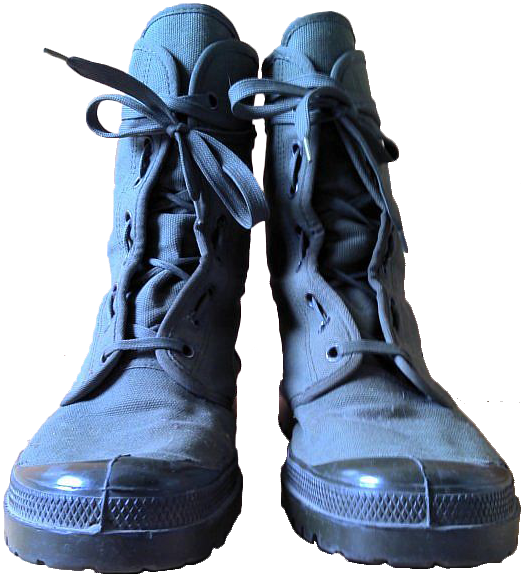
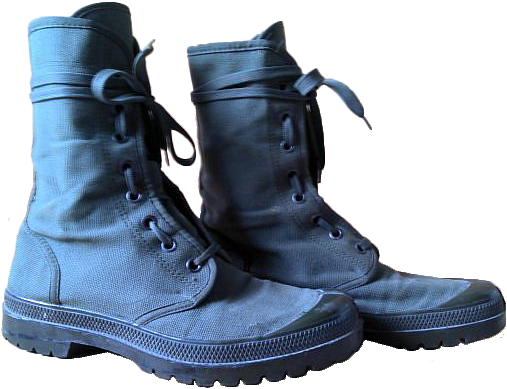
The advantages and convenience of "Pataugas" were quickly appreciated by the potential consumers, and these boots became the favorite footwear for several generations of warriors and tourists. These branded boots were one of the few which had been used in the 1950s and 1960s by the Algerian FLN partisans.
Since 2001, the descendants of Rene revived this brand, and today the "Pataugas" brand now belongs to the "Vivarte" consortium. Philippe Morvan (former art director of the "Pataugas" company ) and Sylvia Bondil resumed the production of this popular budget rubber-soled boots. The cost of a pair of such boots varies, depending on the materials used, within the range from 50 to 150 Euro. Instead of old-days' canvas, leather has become more popular, and leather-topped "Pataugas" make up a significant portion of the range of women's and sports models.
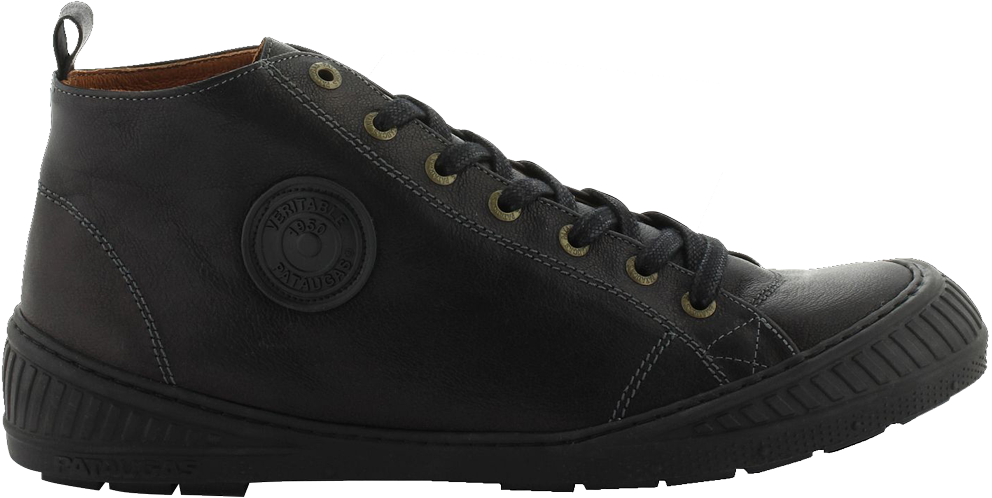
Being focused on the European quality, in the last 15 years "Pataugas" makes its footwear on shoe factories, located in Portugal and Italy, while the preference for natural materials (cotton, rubber, and leather, tanned without chromium is often used for shoe uppers instead of canvas) was determined by the need to comply with the environmental protection requirements.
Returning back to history, let's mention that the company's business was going well until 1960s. The end of the colonial wars, the reduction of the military orders and increased market competition have led the former successful company to deep crisis. On February 25, 1965 the company "Pataugas" was closed. Its founder, Renè Elissabid, died two years later in the same day exactly, on February 25, in his age of 68.
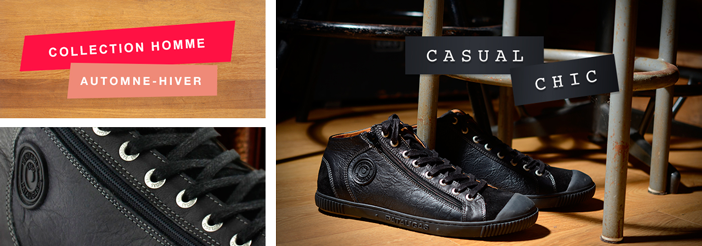
Then the company was successively owned by a businessman from Ales (d'Alès), Louis Clement Saltel (Louis-Clèment Saltel), from 1979 - by the company "Jallatte", then from 1981 - by "Andrè" group ... The next owner, trade company "Harika" from the Valley of the Marne (d'une societè de nègoce du Val-de-Marne, "Harika"), it took 10 years to resume the production, however, this new attempt ultimately ended by the company's bankruptcy in 1994.
After all "Pataugas" failed to regain its full operations. Moreover, in the recent years, its main competitor, "Palladium" company, which was created in 1947 in the region of Isère (l'Isère), has fully seized the initiative. Having adapted its original product ("Pallabrousse") for production in low version (this kind of boot is called "Pampa" ("le Pampa")), and in different color variations, "Palladium" began to sell them not in the traditional "Hunting and Fishing" shops, but....in the fashion boutiques! The result was very fast: the number of pairs grew up from 3 000 pairs sold in 1987 to 1.2 million pairs in 1994, while three-quarters of the production was exported.
The mass-media have informed that the "Palladium" not only commenced a suit against "Pataugas" for copyright infringement and counterfeiting (!) its "original" products, but even won a lawsuit, so "Pataugas" got condemned by a court!
Whatever it was, canvas boots with rubber soles, invented and produced by Rene Elissabid, have come into the history as the "Pataugas"! And many new customers who want to buy "Palladium" boots, are, in fact, looking for the boots, called "Pataugas" ...
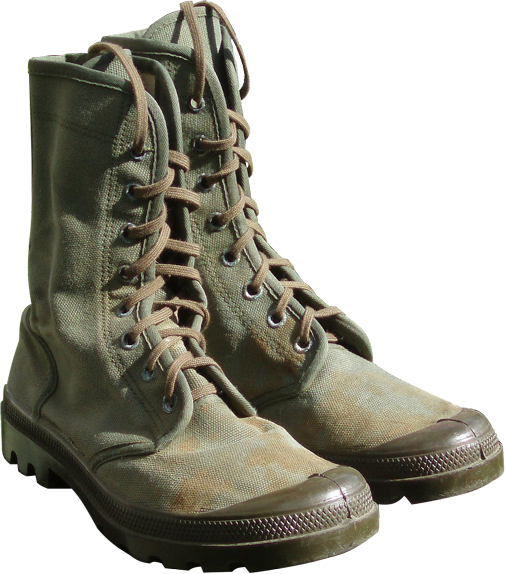

The canvas "Palladium" boots, as it was mentioned before in the review, have been developed by the French company of the same name, which was founded in 1920 as tire manufacturer. The tires, made of layers of canvas and vulcanized rubber) were needed both to automobiles and new aviation industry. The product's quality was so high that soon the majority of aircraft in Europe used the "Palladium" - made tires.
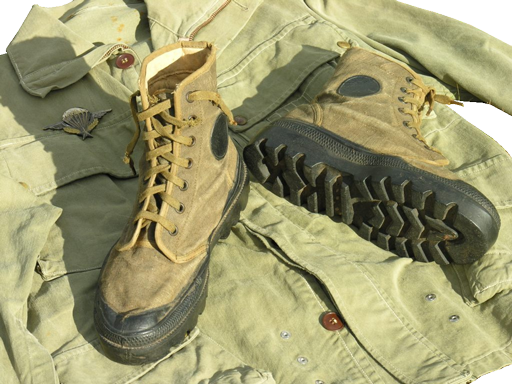
After World War II the aircraft entered the era of recession and demand for tires dropped sharply. So "Palladium" decided to open a factory in Pont De Cheruy, France, and begin production of boots, which would be as strong as the aircraft tires. In 1947, they entered the footwear market with their canvas "Pampa" boots (really famous now!), whose functionality, comfort of wear and durability were so good that the French Foreign Legion began to use these boots widely. The most severe trials have been carried out in harsh desert conditions of North Africa and on the rugged terrain of the Atlas Mountains.
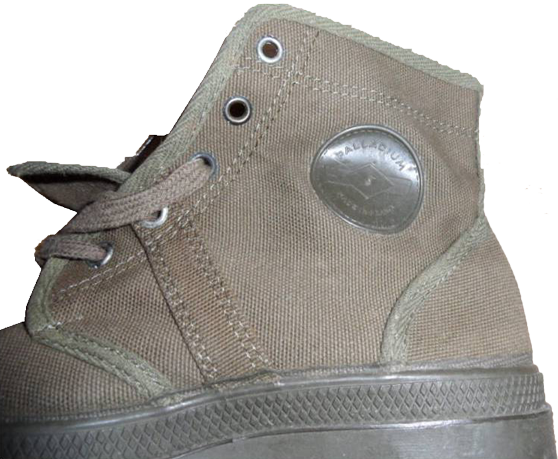
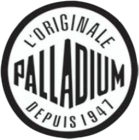
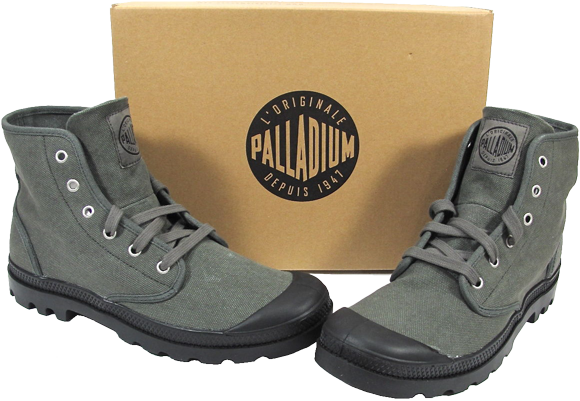
The photo shows typical "Phoenix" boots by "Palladium", with recognizable tread soles, exactly the same as in the current versions of these boots. However, this tread pattern was not the only one, for example, they also used a variation of "Vibram" tread pattern, where the "crosses" on the pattern were replaced by "triactinal stars". The soles were initially black-colored later they were produced in green color as well. On the image of green soles, one can see the model manufacturer's name ("Phoenix - Palladium"), the size, the country of manufacture "Made in France", and the manufacturer's logo - a diamond, combined with the elongated rectangular lugs.

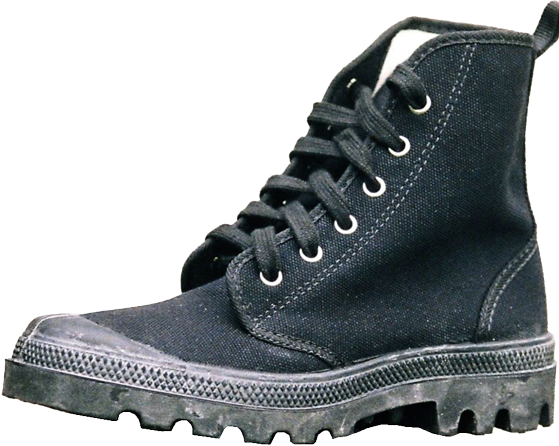
It is interesting to note that the elements of the logo, are "written inside" the tread pattern of the soles: in front of the heel, just below the inscriptions on the sole, there are two rectangular lugs, while the heel features the "diamond"-shaped lug, "integrated into the rectangular log. This "diamond" had previously been "blind", but later it got a hollow (cut) inside, to facilitate more lightweight soles. This later "hollow diamond" version of tread pattern in used in the modern versions of "Palladium".
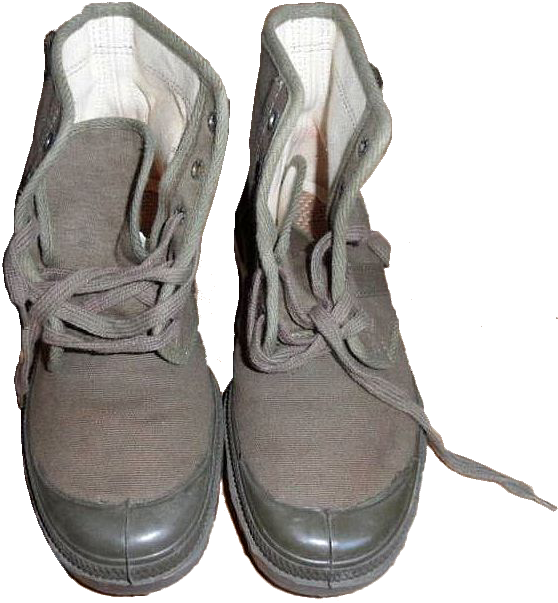
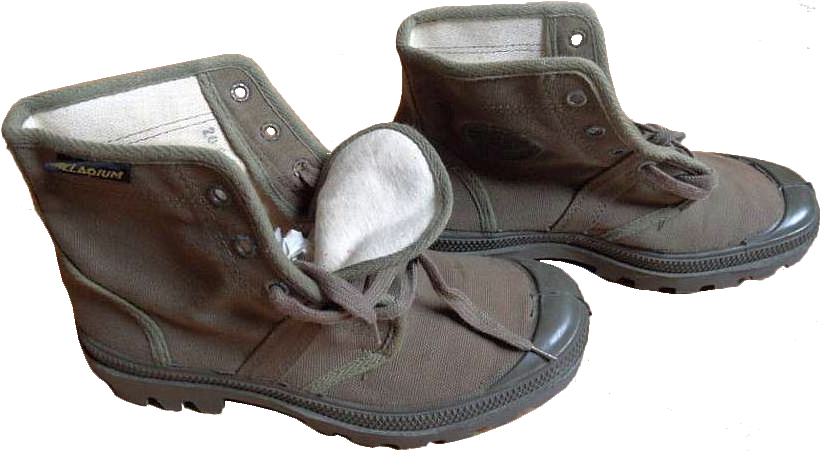
The height and the number of lacing eyelets was various in different years. The differences can be found in minor details as well: the presence or absence of a series of circular grooves on the heel and the toe, or the same "blind" or solid "diamond" on the heel.
In Israel, some companies began the production of copies of "Palladium" canvas boots. One of them, "Dafna" Kibbutz, was mentioned in the review of the Israeli army military boots - "Dafna" Pataugas.
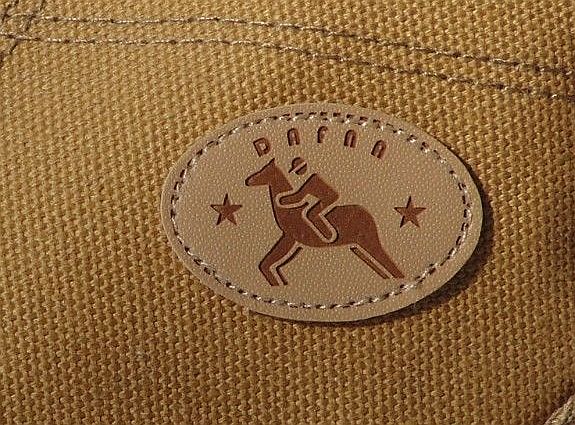
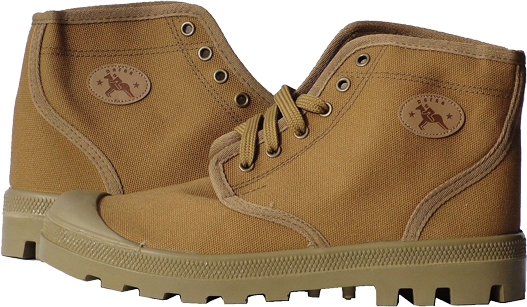
The word "Daphna" in Hebrew means "Laurus" (Hebrew. הבפד: (Laurel) רע, הבפד, lat. Laurus), i.e. the southern evergreen wreath of branches which is an ancient symbol of victory, fame and awards. The Israeli beige canvas boots produced by "Dafna" feature visible oval protective label patches at the leg bones, indicating the producer and logo - a jockey on a horse and two stars.
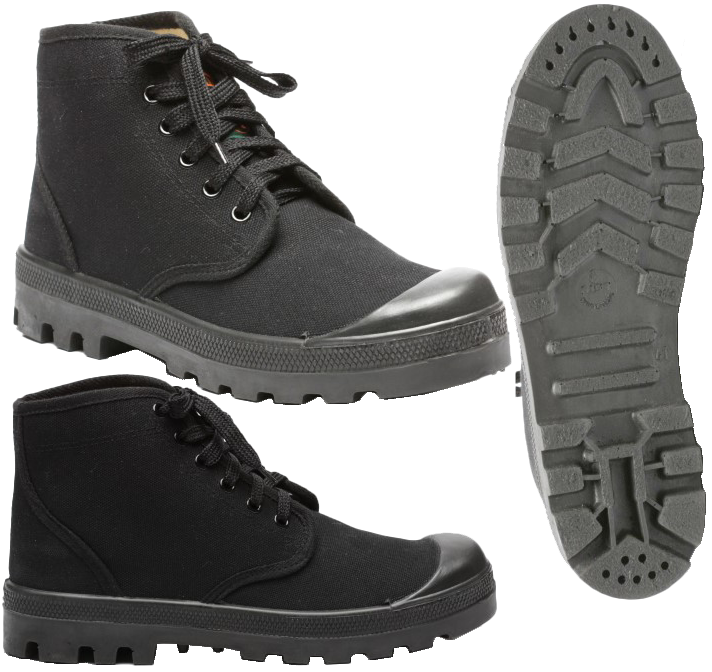
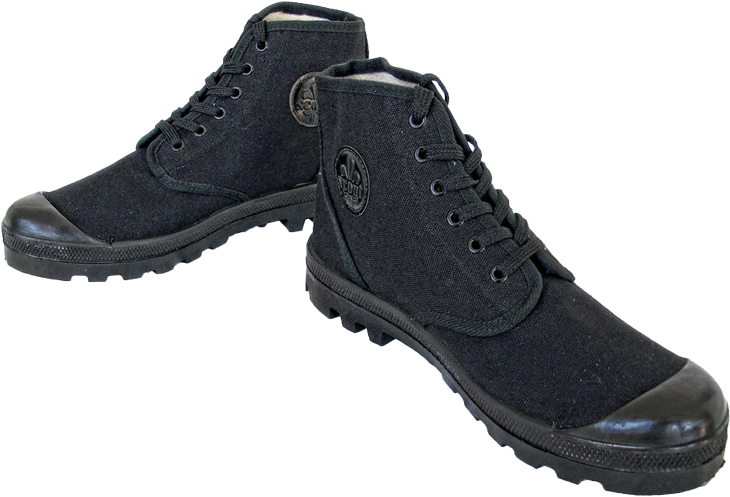
Some users of the Israeli canvas boots pointed out the weakness and superficiality of the heel's tread pattern: thin bridges between the larger lugs of the pattern tend to wear out and crush down quickly, that soon leads to accelerated mechanical wear of the heel and discomfort of wear. Indeed, the French originals feature no thin and weak lines in the figure on the heel: all the original versions feature simple, strong and functional patterns of the heel treads. One could only ask the question, what is the reason of worsening the old good and proven tread patterns....
This leads to a more or less logical explanation for this: the authors of the Israeli "clones" wanted to bring a unique element in the copies they produced, and to "write down" the Hebrew letters of their logo ("daled" and "nun") in the tread pattern of the heels.
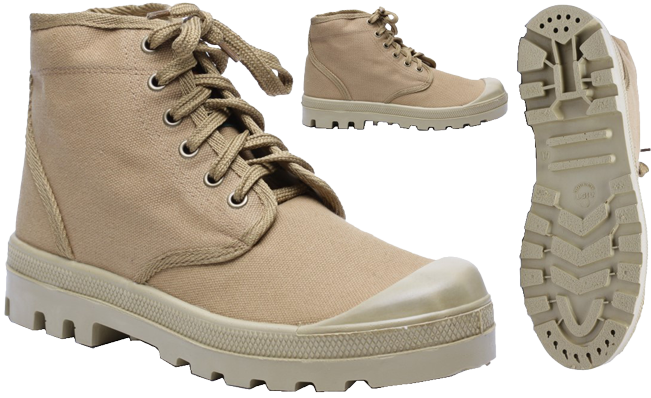
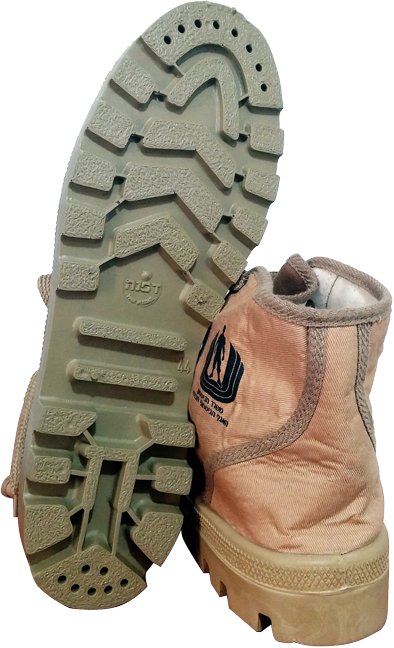
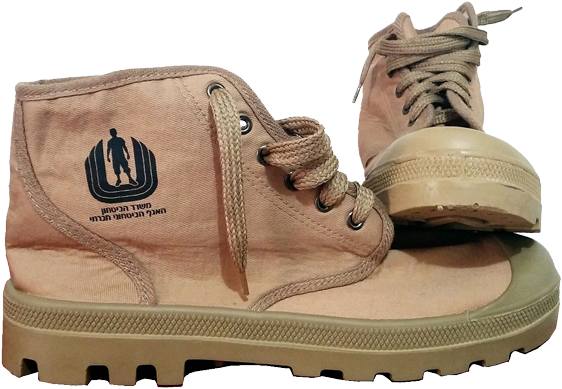
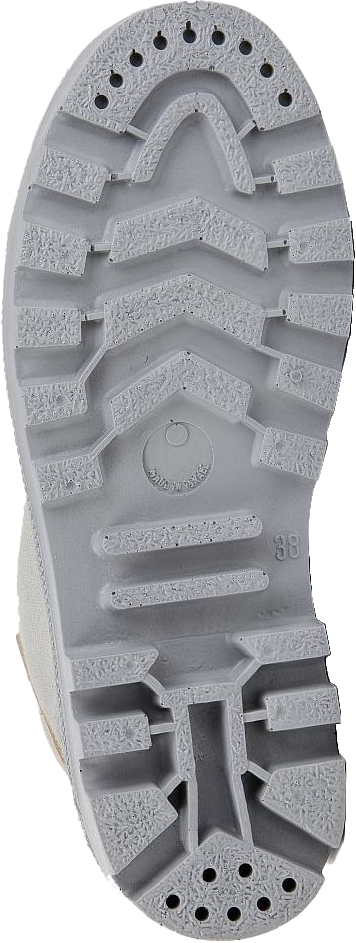
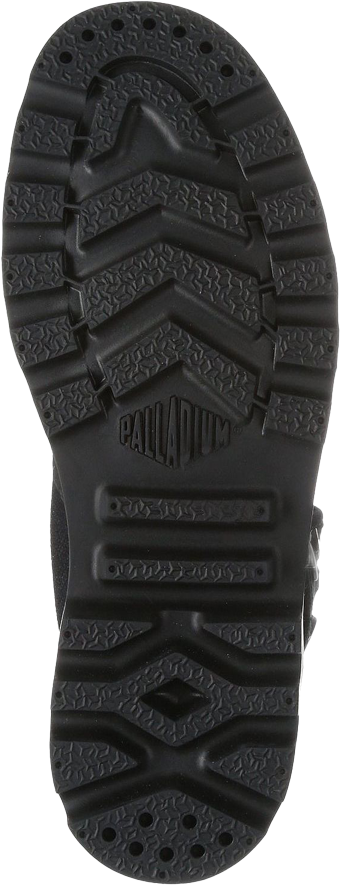
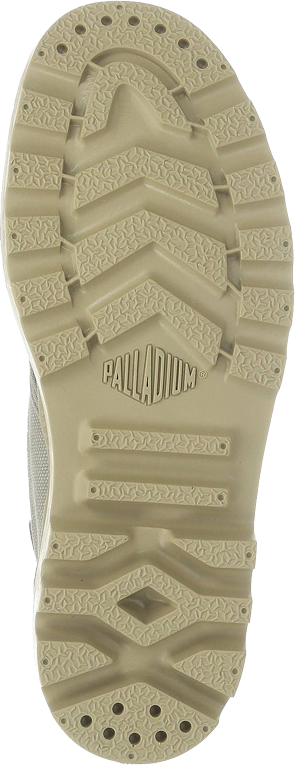
The photo above shows the examples of the Israeli version of "Palladium" canvas boots labeled in Hebrew. Black lower version of "Pampa" boots feature labeled protective round-shaped rubber pads with the inscription "SCOUT" and "Fleur de Lys", the French heraldic symbol.
For visual comparison there are also presented the tread soles patterns of the Israeli-made "clones" (gray and olive) against the original "Palladium" (black and beige), and one can note the clearly visible differences between the tread patterns of the heels.
One can also assume that this peculiarities may be related to the tread copyrights, which indirectly confirms similar example with the "Mil-TEC" company, which produces, in particular, the significantly deteriorated copies of the US military "jungle boots", but, for some reason, the tread patterns on the heels of the left and right boots were mutually swapped.
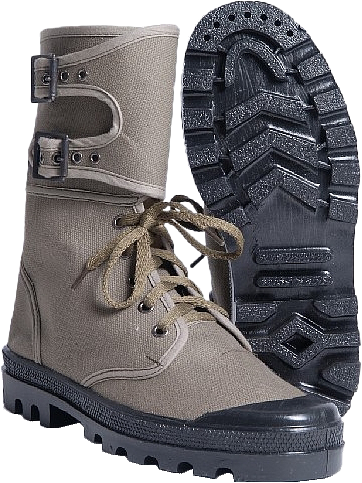
This appears to be a real nonsense, since the original American "jungle boots" feature massive and the strongest part of the heel pattern exactly on the places of the most serious load, with a high degree of tear-and-wear. In the fakes by "Mil-TEC" (aka "Teesar Inc.", Cartersville, GA, for the American market) the tread pattern shows deep hollows on the areas of the heels where serious mechanical load is usually applied, so the heels wear out very quickly on these points, and soon look like punctured and deflated tires. However, these fakes are not designed for long comfortable wear, and by the time the heel wears to this extent, the leather top starts to tear at the backdrop junction with the heel.
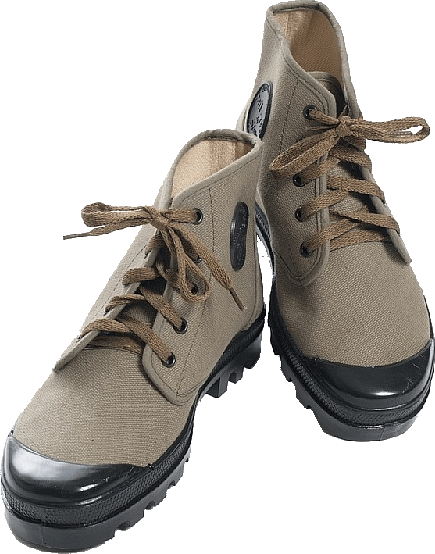
From the very beginning the "Pataugas" were "low", i.e. "high" canvas and rubber boots with the gaiter and buckles didn't come around in Indochina or Algeria until the early 70's. "Palladium" is producing the same exact boot hat they were in 1947, except for the insole and some minor details of the out-sole tread pattern.
"Palladium" boots are no longer manufactured in France, but like most modern footwear are China- made. These "Palladiums" are obviously more "heavy duty" and better fitting than the Israeli copies. "Palladium" is definitely very proud of their brand name, and they use to place their tag on four locations of each boot exterior.
One is on each tongue of the boot; another tag is placed just below the laces, being stitched into the outside seam side of each upper; the third none is placed on the bottom of the sole; and the last one is on the protective round-shaped ankle patch of rubber, as it was done originally, albeit in a different styles. On the inner side of each boot there is also an interior printed tag, with bar-code, manufacturer's code and size, and the inscription "Made in China".
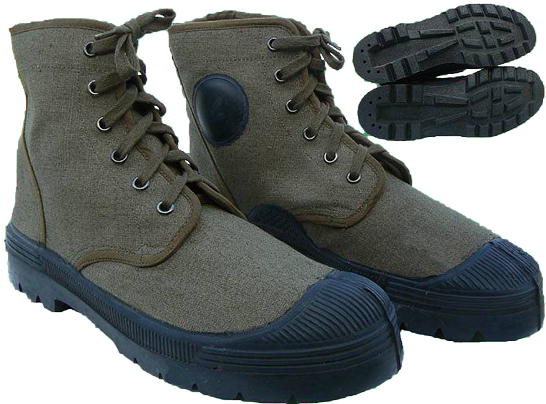
The French "Pataugas"-type boots, either high-leg models (with two buckles on top or without them) or low ones (the so-called "Pampa" boots), costing about 80 UD dollars in retail trade, consist of the following parts:
- the cleated chunky-looking one-piece molded out-sole is made of thick rubber with stamped manufacturer's mark (Bonusage, Morvan, Palladium, Paraflac, Pataugas, Paul Boyé, Vernon, Wissart...), also they had two-piece sock-liner, featuring hugging thick die-cut EVA and protective rubber toe-cap for better fingers protection. The height of the heel was about 1 inch (2,54 cm);
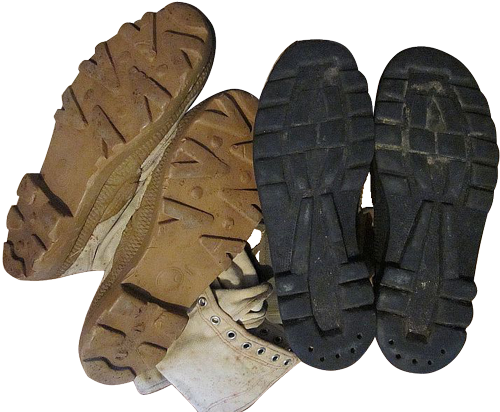
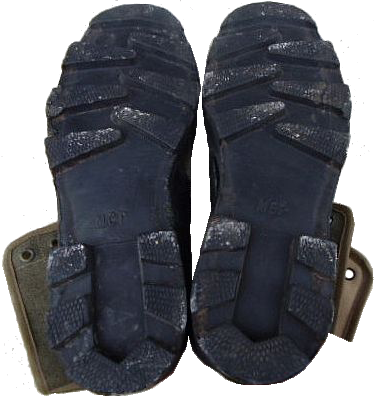
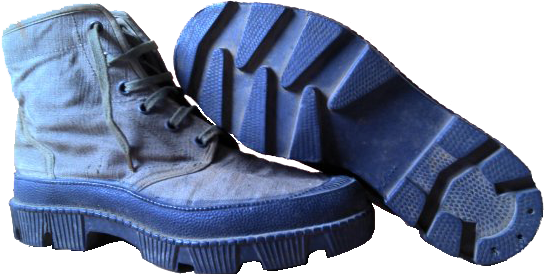

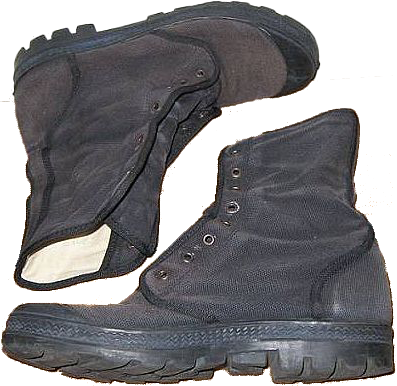
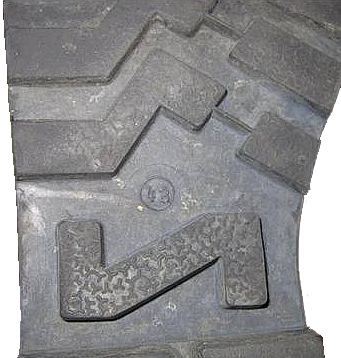 - thick 100%-cotton olive-green canvas fabric upper, weighting about 20oz (about 567 grams) for a single boot, the color may differ for various manufacturers (from tan and green to black shade);
- protective round rubber patches are applied on medial side of both boots and often marked with manufacturer's brand name, sometimes they show no marking at all. The producer's brand names can also be found on the out-sole, boot's tongue, inner stamps and even on the edge of rubber soles in the heel area.
- thick 100%-cotton olive-green canvas fabric upper, weighting about 20oz (about 567 grams) for a single boot, the color may differ for various manufacturers (from tan and green to black shade);
- protective round rubber patches are applied on medial side of both boots and often marked with manufacturer's brand name, sometimes they show no marking at all. The producer's brand names can also be found on the out-sole, boot's tongue, inner stamps and even on the edge of rubber soles in the heel area.
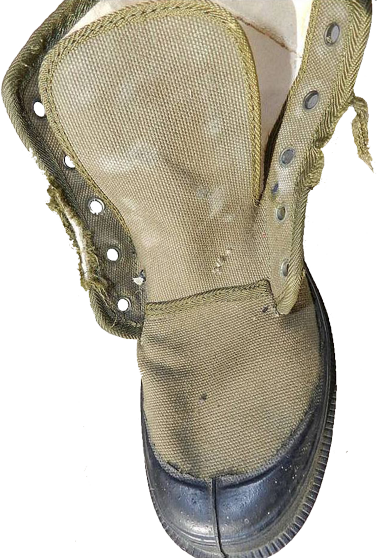
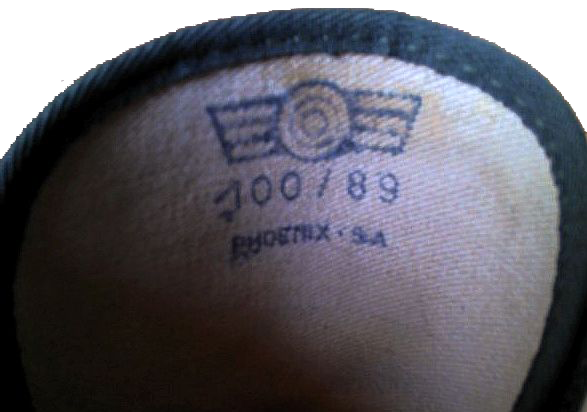
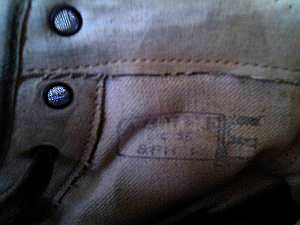
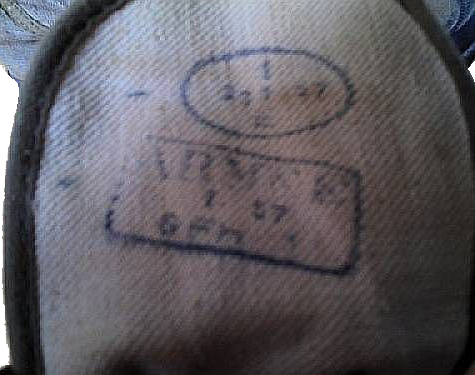
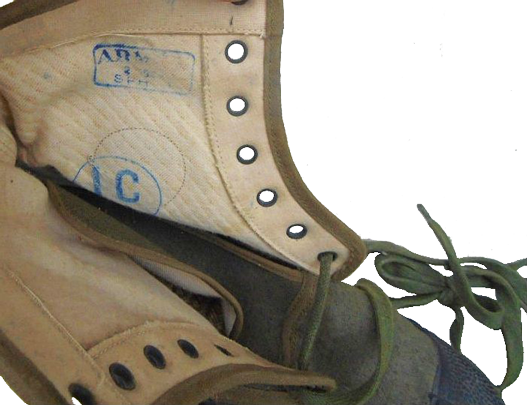
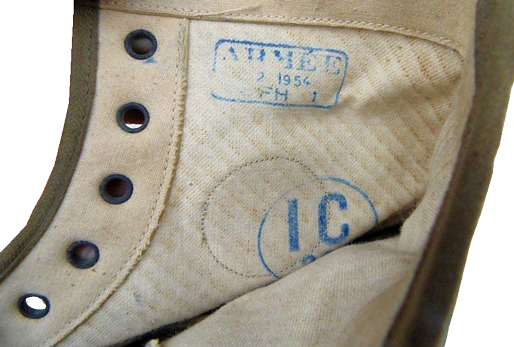 - the models with the cuffs and buckles at the top were different as well: in the earlier versions the straps and buckles fixing base patches were made of leather, they were sewn-on separately, and the straps had five holes. On the later models the straps were made of canvas, and presented by themselves the single unit, while each leather strap had four holes for the buckle teeth.
- the models with the cuffs and buckles at the top were different as well: in the earlier versions the straps and buckles fixing base patches were made of leather, they were sewn-on separately, and the straps had five holes. On the later models the straps were made of canvas, and presented by themselves the single unit, while each leather strap had four holes for the buckle teeth.
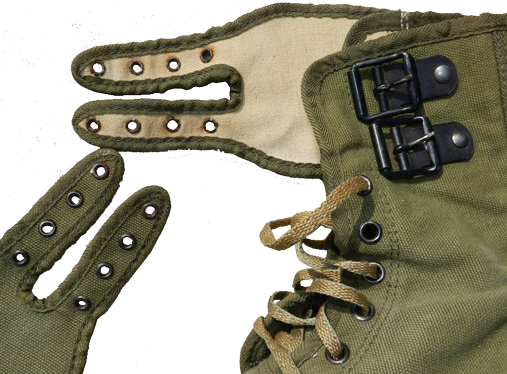
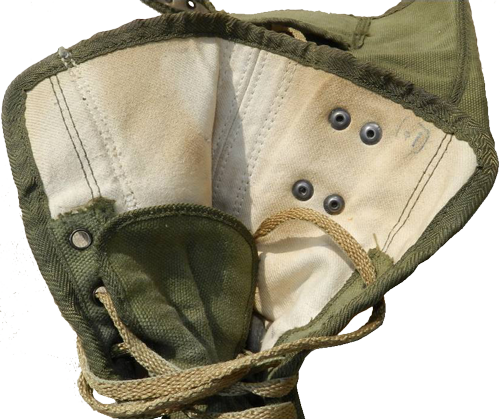
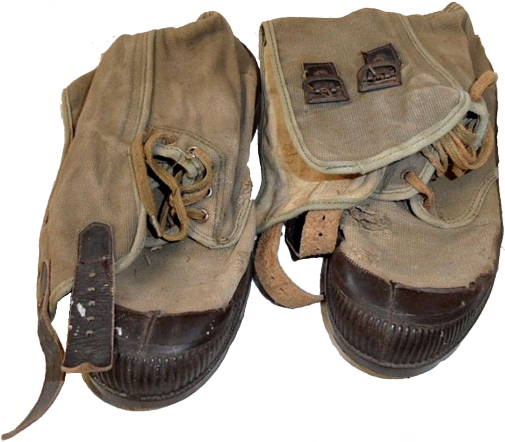
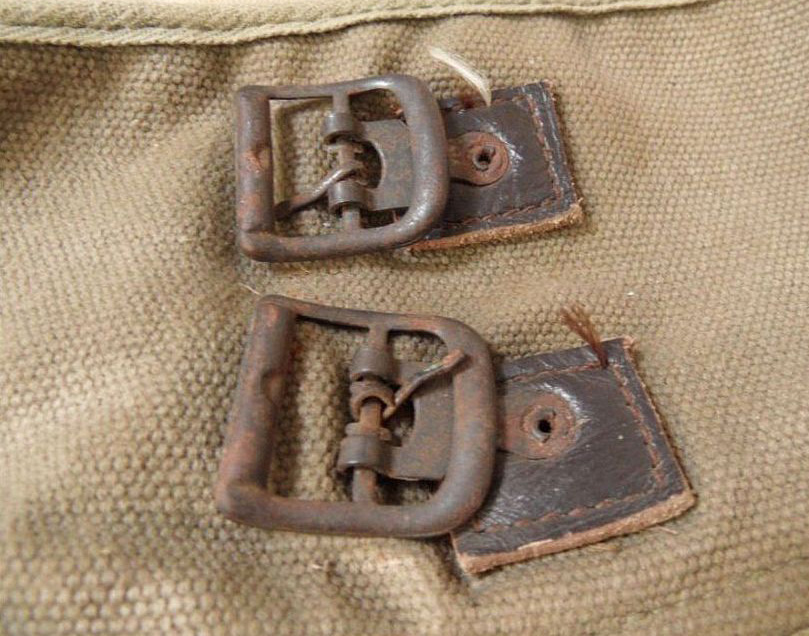
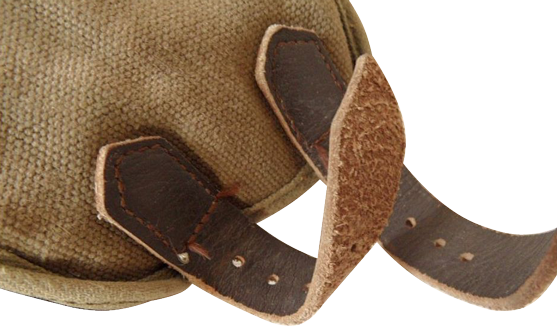
The materials from which the "Pataugas" boots were made

Further on, the armed forces placed the orders for "Pataugas" in a number of private companies, and around the mid-1950s, the French troops used a variety of models with the marks of different manufacturers. All the models were made of the same materials: rubber and canvas (of linen or cotton), and the colors varied from dark green or olive-green to light khaki.
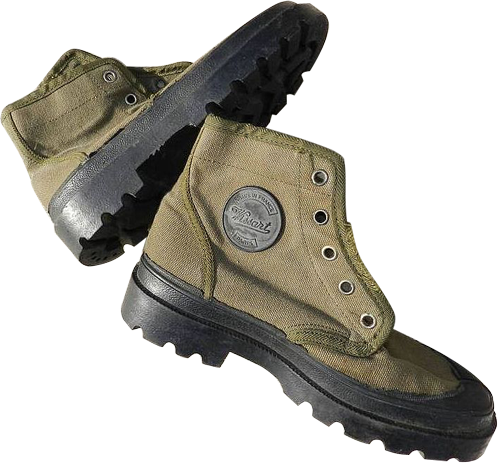

These boots were both low and high, with protective cuff featuring two buckles or without it. The following image shows high (13 pairs of lacing eyelets) "Pataugas" boots, khaki-colored with brown rubber out-sole, made by "Palladium". The tread pattern of the soles consists of interleaving "V"-shaped and round lugs. Additional canvas strips of the same material as the boot's top are sewn on the level of the third pair of eyelets (counting from the bottom) and serve for the general structural reinforcement. On the inner side of the foot, an additional protrusion of the rubber boot sole is provided for more anatomically-correct shape. These boots feature no protective round rubber pads covering the malleolus bones.
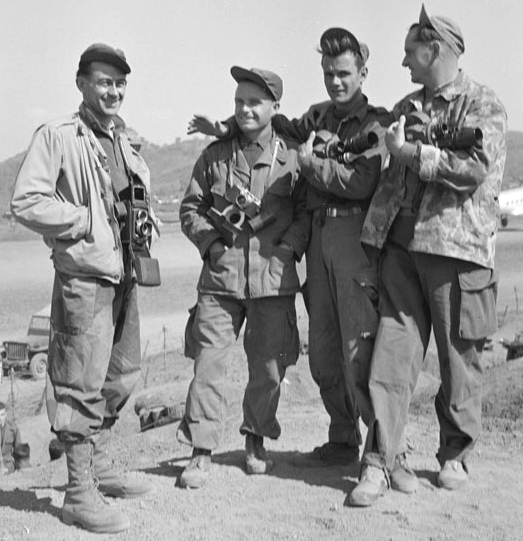
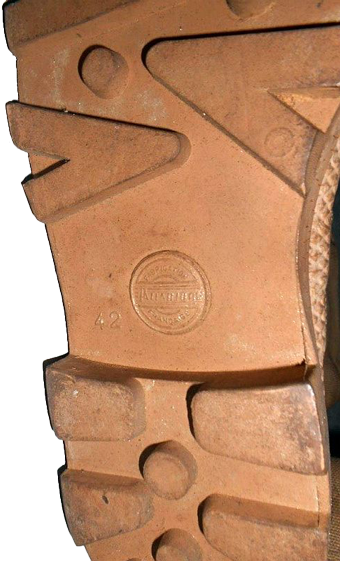
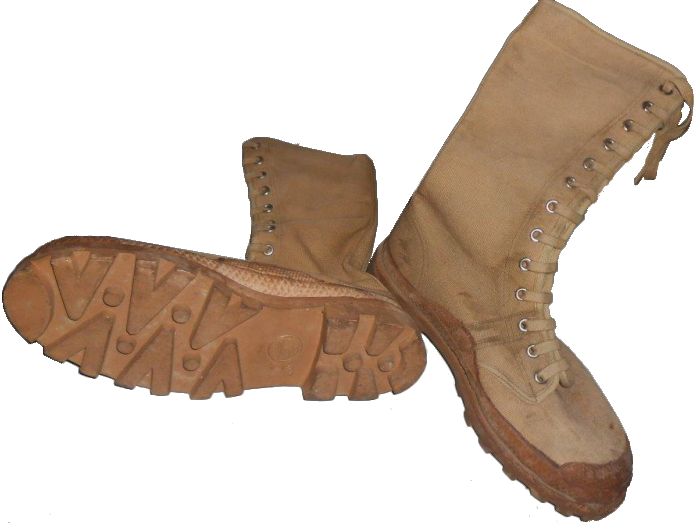
The number of lacing eyelets, naturally, depends on the height of the boot, and can range from 5 pairs in the lower models up to 13 pairs for high khaki-colored model on a brown out-sole.
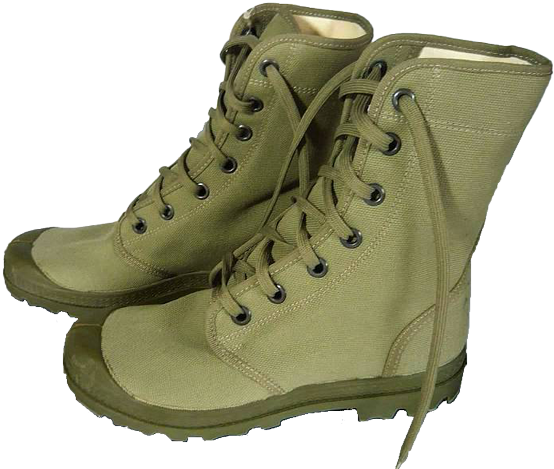

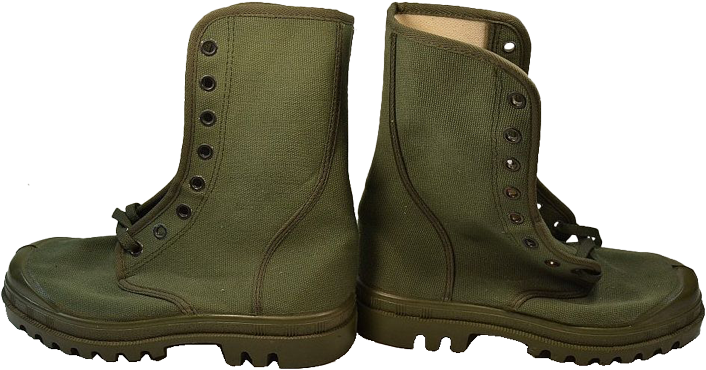
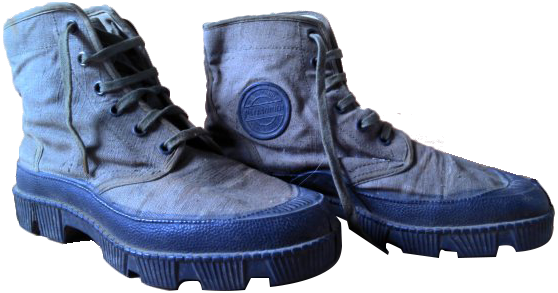
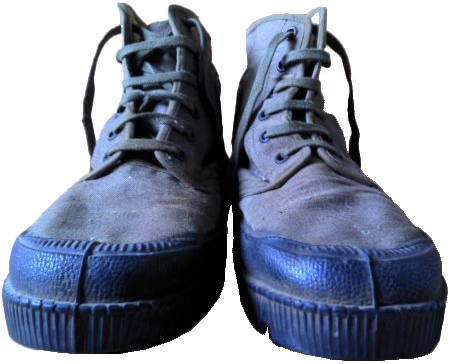
Additional toughness of the boots was provided by an increased stiffness of the out-sole, namely, by the rubber lugs and pads, which protect the toes and the inner sides of the feet. The height of the heel was typically 2.54 cm (one inch). Many models, similar to "keds"-type sneakers, featured round pads of rubber to protect the malleolus bones, and often bear the indication of the manufacturer's name. The tread patterns of the out-soles (black-colored in early models, black and green in more new models) were significantly different depending on the manufacturers.
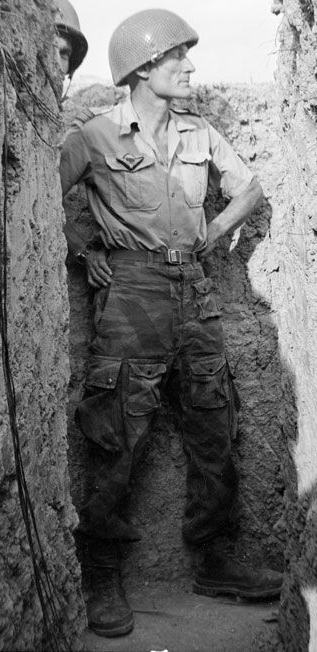
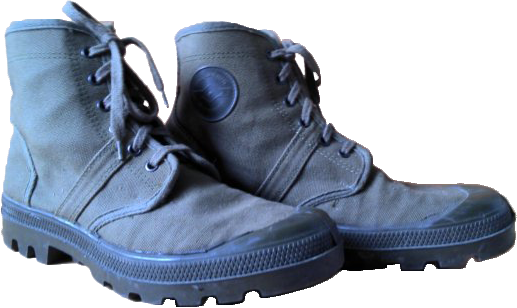
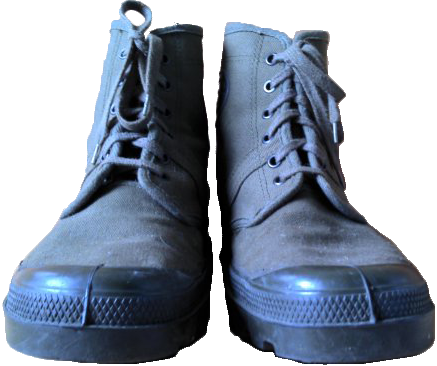
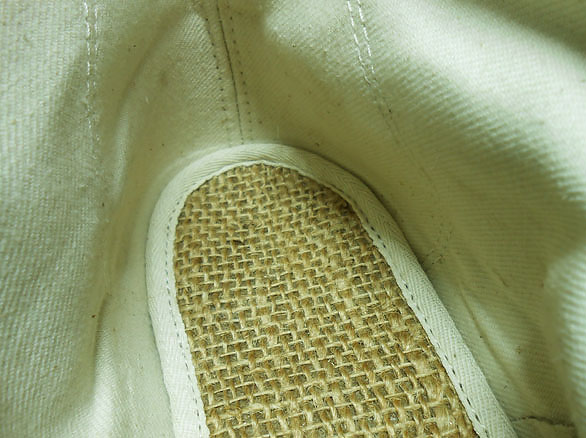
The early models show more rough and simple tread patterns of the out-soles. Usually inside the boots were placed removable woven insoles made of natural plant material (jute or hemp stalk).
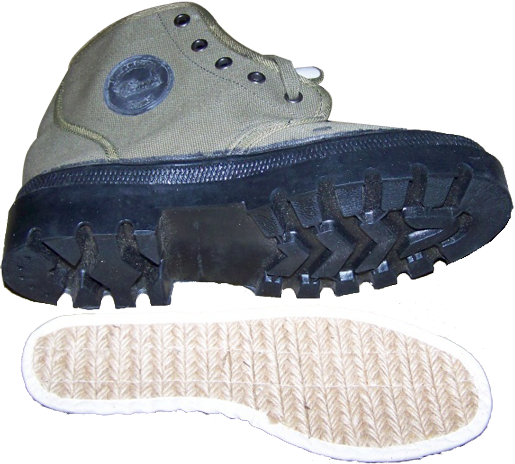
In some models, the insoles were equipped with thin steel plates to protect the feet from any thorns. Depending on the manufacturers, the boots had different features such as the height of the boot lacing, number of lacing eyelets, the presence of additional fabric collar with buckles (similarly to the leather boots model BMJA Mle 52-65).
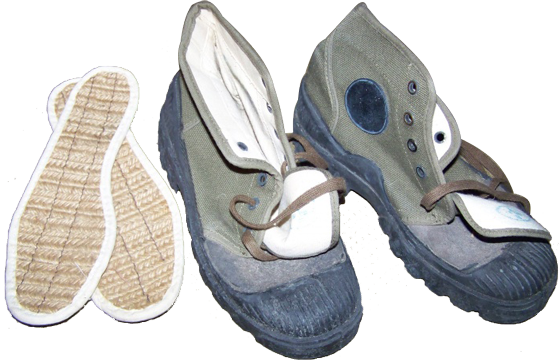
In the early 1960s, all the manufacturers of French military canvas boots began to use strong nylon thread, which increased the longevity of use. These boots gained high popularity because of their extreme simplicity, lightweight feature and lack of need in any care of them, even among those who have always preferred strong leather military or jump boots. The "dark" side of convenience, ease and simplicity of these boots was their relatively rapid wearing-out during heavy use, especially on hot stony plains of North Africa. In practice, this problem is compounded by the fact that it was very difficult to get a new pair of such boots promptly (within a reasonable time) in correct size, and the quartermasters often refused to issue new boots, and even more often very the military warehouses simply ran out of such boots, while there were problems with delivery.
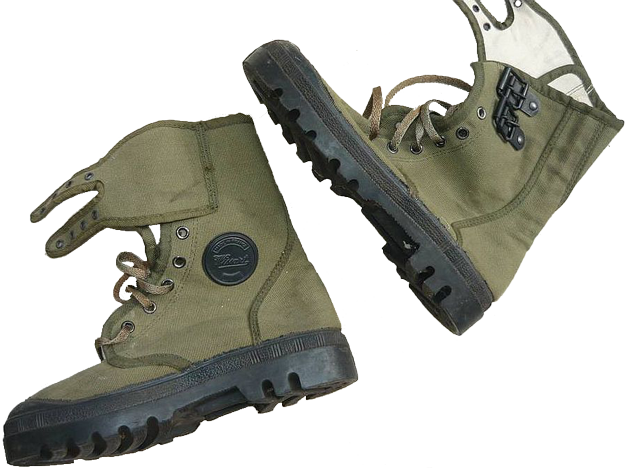
This led to the situations when the French soldiers often were forced either to buy privately the replacement boots at their own and pay shipping from France, or to buy locally made boots directly from vendors on-site. Theater-made boots were often of different colors (from dark brown to light sand) and often showed full absence of any identifying marks and manufacturer's labeling. Sometimes they had to use simple "Converse"-like sneakers (it often happened during the conflict in Indochina), or even the captured trophy boots, among which the best quality canvas boots were those made in Egypt for the Algerian National Liberation Front guerrillas.
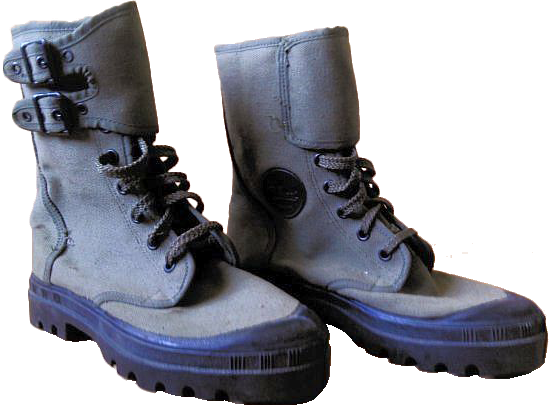
For many years, during the colonial wars in Indochina and North Africa, the "Pataugas"-type canvas boots had been an integral part of the image of the French soldiers and legionnaires.
The colonial wars of France in Indo-China, of course, had an impact on the uniform of all the countries, involved in the regional conflicts. Different official issue French-made boots were sent to the South Vietnamese army as the French aid. As for the military canvas boots, Vietnam, the most belligerent country, managed to start the production of analogues of the French canvas boots, however, with the addition of some local innovations.
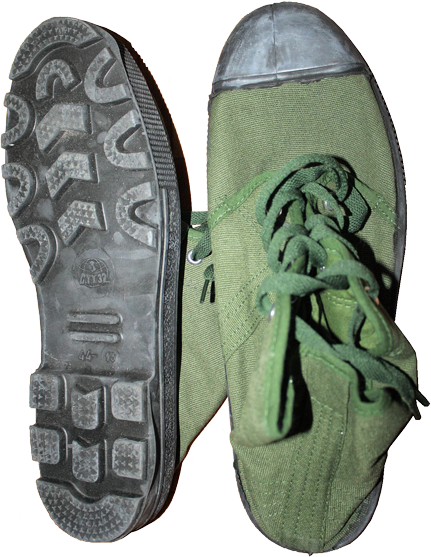
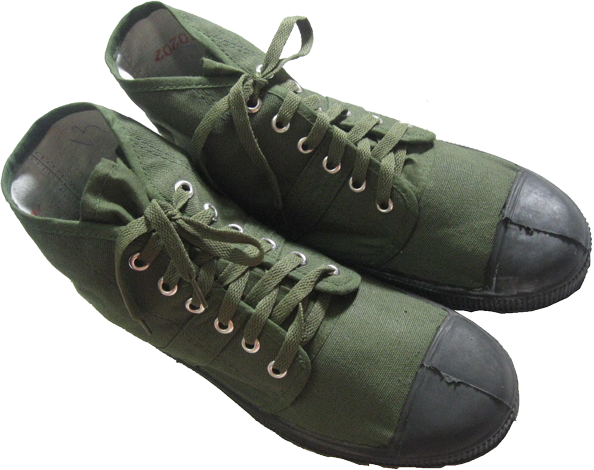
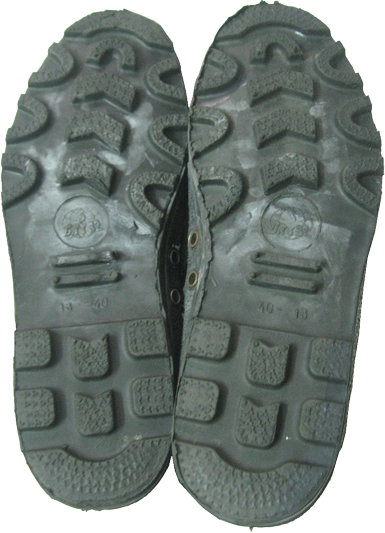
The Vietnamese version of "Pataugas"-type "Pampa" boots are made of green canvas and looks more roughly made than the French ones, especially concerning black rubber sole, the tread pattern of which, judging by their appearance, represent by itself a combination of ideas, borrowed from different French manufacturers. Thus, the half-ring-shaped lugs along the edge of the foot are definitely borrowed from "Aigle" tread pattern, while the angular-shaped central elements were taken from "Palladium", as well as two transverse elongated rectangular lugs in the middle part of the sole, just near the heel. These elements of thread pattern are intended to absorb the load in the middle of the foot, and thanks to them the sole of such boot is not flat, but correctly anatomically curved. However, the borrowing of transverse elongated rectangular lug turned out to be some timid, and these lugs appeared to be too small and thin.

Nevertheless, they managed to compose a distinctive "Vietnamese" tread pattern, which was different from all the other patterns, and this allows to distinguish the "friend" and "foe" footsteps on the ground. The Vietnamese also "borrowed" from the American "jungle" boots the idea of double eyelets at the inside shank of each boot. These brass drainage eyelets, intended to allow water to drain out and to permit air to reach the feet inside the boots, were not screened with fine mesh, as distinct from the Americans "jungle boots". This simplification made possible the ingestion of insects inside the boots, but made the boots production cheaper. The manufacturer's labeling logo can be found on the sole, depicting the globe and the contour of Vietnam, and the manufacturer's code (for example, CTY 32 and 32 BTY, as well as the size and width ("44-13" and "40-13"), arranged in a mirror manner on the left and the right boot.
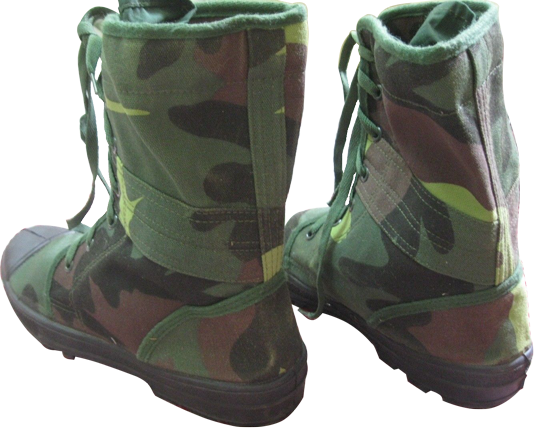
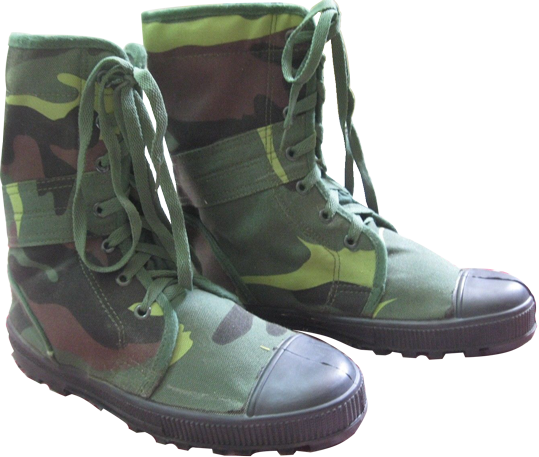
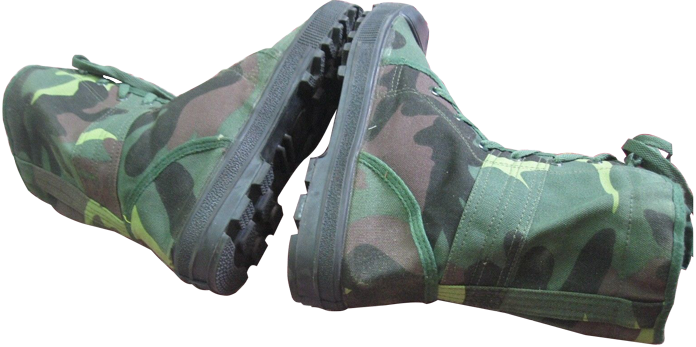
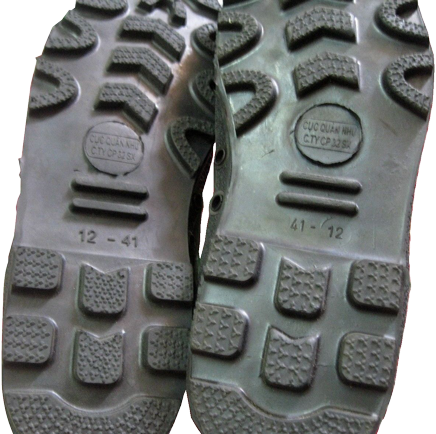
The figure above shows Vietnamese-made high canvas boots with a top of camouflage, reminiscent American "Woodland - ERDL", but with more bright colors. Historically there were no French "Pataugas"-type boots with camouflaged canvas top, so this can be considered as the Asian invention. These boots are made similarly to the low green boots version, but characterized by a lack of ventilation and drainage eyelets, and the construction of the top was reinforced by canvas stripes in the middle part of the top, on the level of the fourth pair of eyelets, counting from the bottom.
Most often among the original manufacturers of the French "Pataugas" boots one can find the following brand names: "Aigle", "Au Coq", "Bonusage", "Morvan", "Palladium", "Paraflac", "Pataugas", "Paul Boyé", "Vernon", "Wissart", etc. ...
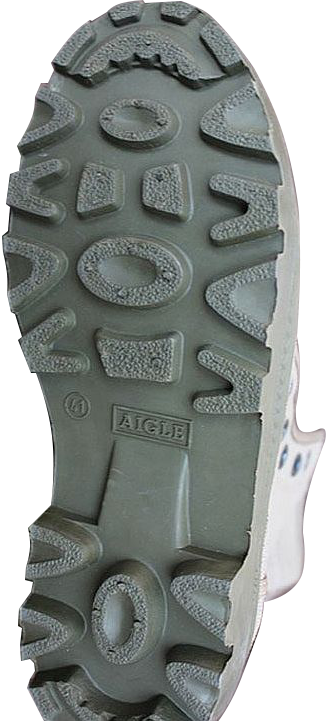
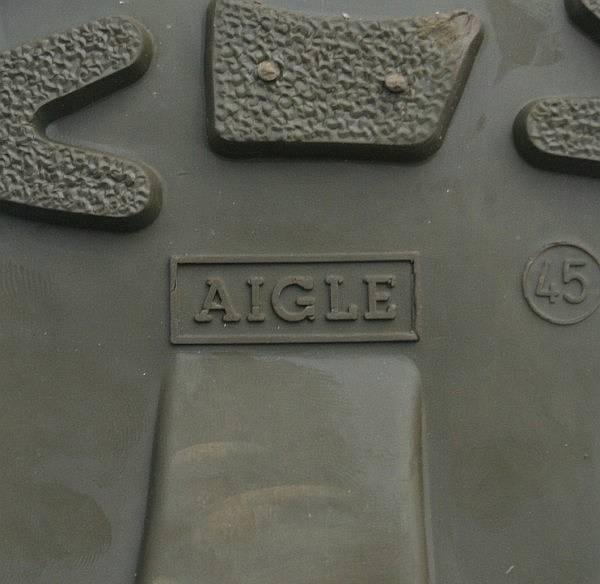
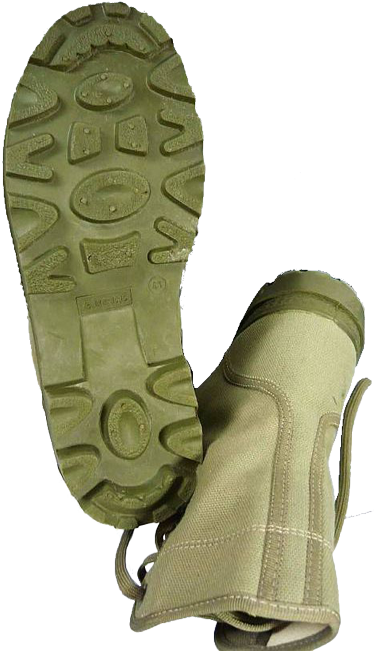
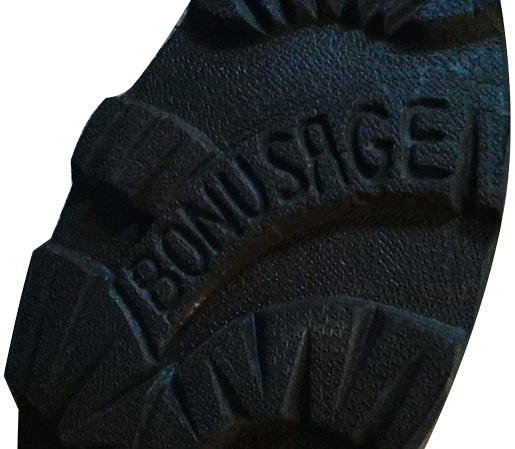
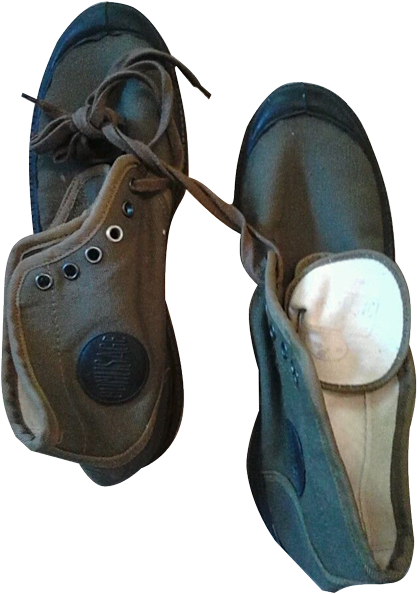
The "Pataugas", produced by the "AIGLE" company (French for the "Eagle") comprised the olive-colored canvas top and the green rubber out-sole, the tread pattern consisted of "V"-shaped, rectangular and round lugs, while the boot size and the manufacturer's label were indicated on the sole.
The boots model produced by "Au Coq", adopted in 1958, featured more thick rubber layer on the heel (this model looks more massive than most similar models by the other manufacturers) and the top of relatively more light-colored fabric.
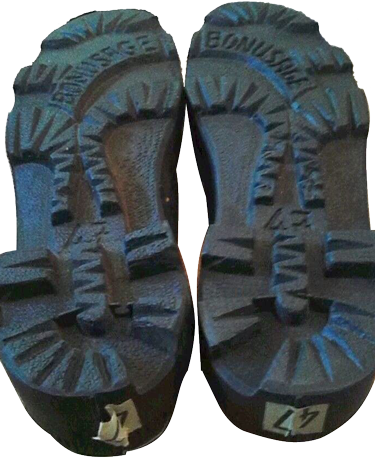
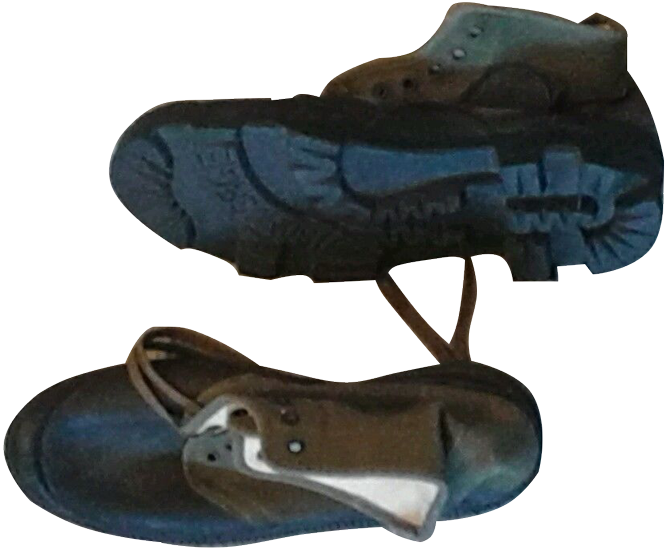
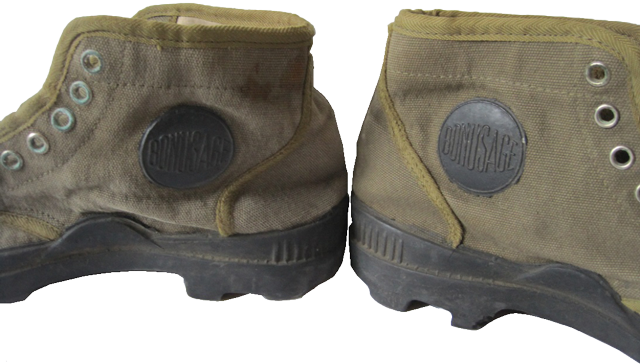
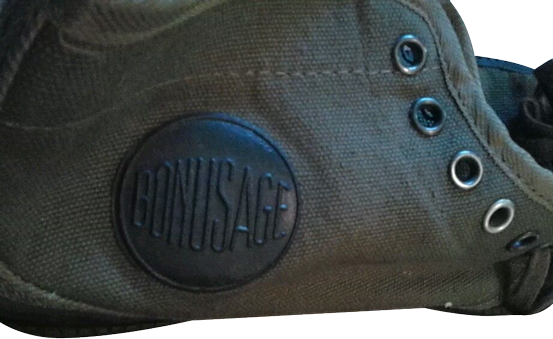
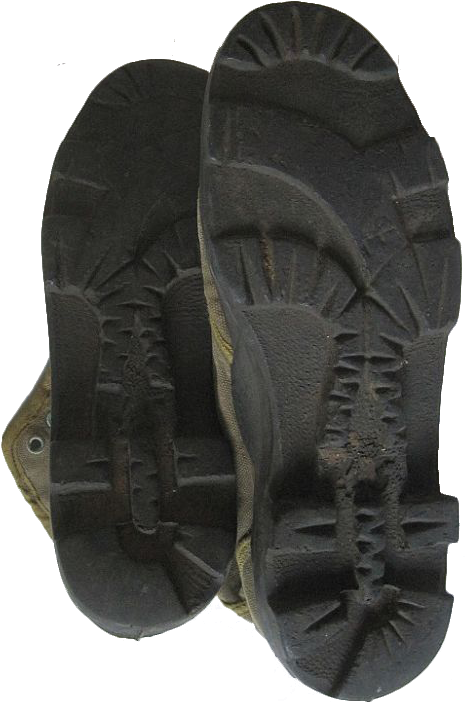
The "Pataugas" model by "Bonusage" (chaussures de brousse de marque "Bonusage"), which were approved in 1957, also features a massive black rubber out-sole of very specific shape (with big-scale tread pattern and wide lugs), but they were low and with just five pairs of aluminum lacing eyelets. Thin nylon parachute cords were used instead of laces due to their superior strength and durability versus the standard cotton laces.
The contract boots by "Morvan" (chaussures de brousse françaises du commerce "Morvan"), which were adopted in 1954, resemble the first model by "Vernon", and feature the out-sole with large "V"-shaped lugs.
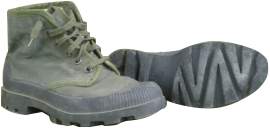
Among the canvas boots made by "Vernon" there were several different models:
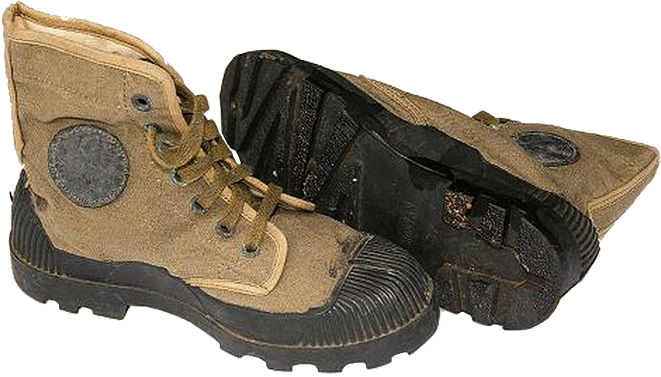 - The model, adopted in 1955, differs by high thick rubber out-soles with dense tread pattern and seven pairs of steel lacing eyelets. The toes are covered with protective rubber cap, protruding towards lacing, and with stripped surface, typical for the "keds"-like sneakers;
- The model of the year 1957 was modified considerably compared to the previous one, the rubber out-sole became thinner and has become a little more low, while the number of lacing eyelets was reduced to five. The malleolus bones of the feet are covered with protective round- shaped rubber pads at the inside shank of each boot.
- The model, adopted in 1955, differs by high thick rubber out-soles with dense tread pattern and seven pairs of steel lacing eyelets. The toes are covered with protective rubber cap, protruding towards lacing, and with stripped surface, typical for the "keds"-like sneakers;
- The model of the year 1957 was modified considerably compared to the previous one, the rubber out-sole became thinner and has become a little more low, while the number of lacing eyelets was reduced to five. The malleolus bones of the feet are covered with protective round- shaped rubber pads at the inside shank of each boot.
The French magazine "Uniformes" No 266 of September-October 2009, has reported: "Ces chaussures de brousse de marque Wissart, rèceptionnèes de 1956 et observèes ponctuellement durant la guerre d'Algèrie, se caractèrisent par l'utilisation d'une pièce de cuir pour l'empeigne (côoté brut à l'extèrieur))", that means "canvas boots produced by "Wissart", adopted in 1956, were widely spread during the war in Algeria, and were characterized by the use of natural leather over the top of the foot" (i.e., between the toes the bottom of the lacing).
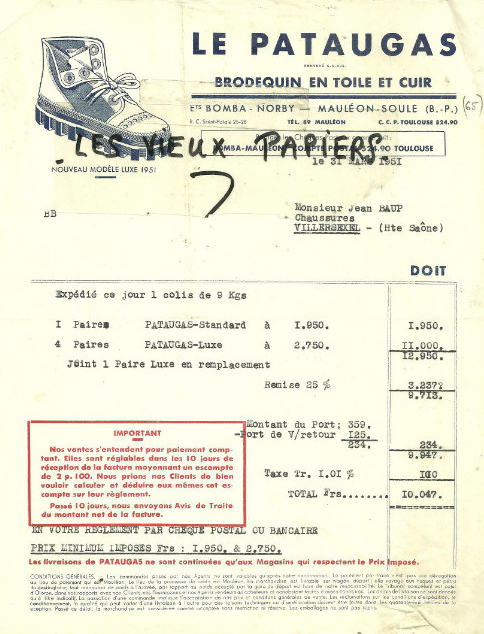
This is a fairly rare model of "Pataugas"-type canvas boots, and in the process of research I managed to find the photo of the invoice (payment document), dated March 31, 1951, featuring the image of these boots. This invoice informs us about that new model of the year 1951, "Le Pataugas - Brodequin en toile et cuir" (i.e. boots of canvas and leather). These boots feature perforated leather cup on the toes and the front of the feet, and, judging by the address on the payment document, the order went to the factory "Pataugas" in the city of Maulèon-Soule.
The boots made by the company "Pataugas" feature the out-soles tread patterns, very similar to the classic "VIBRAM" tread pattern, with minor modifications. On the sole one can see the reference of the country ("Made in France"), manufacturer ("PATAUGAS"), size (in this case 42), and, surprisingly, even the upper material/lining - "tige coton" (French for "Cotton wool/ wadding").
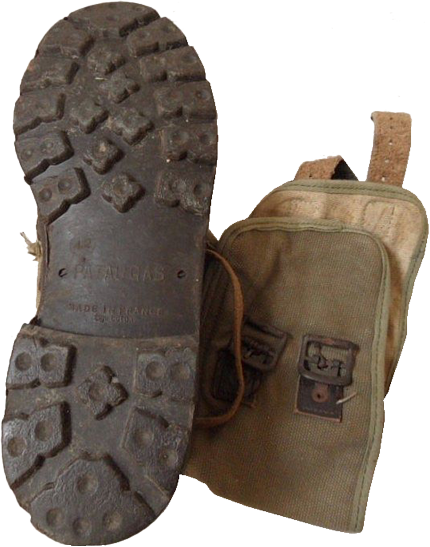
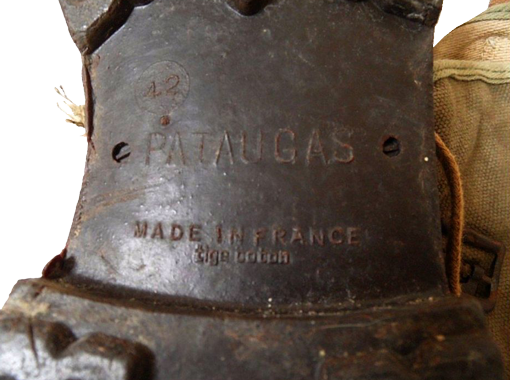
The "Pataugas" by "Paraflac" are rare, nevertheless, they were used during the major conflicts in Indochina and North Africa. As it was mentioned earlier, virtually all of these boots featured removable insoles made of woven dried and processed hemp fibers - very hygroscopic, quick-drying, natural, heat-isolating and pleasant to skin insulating material.
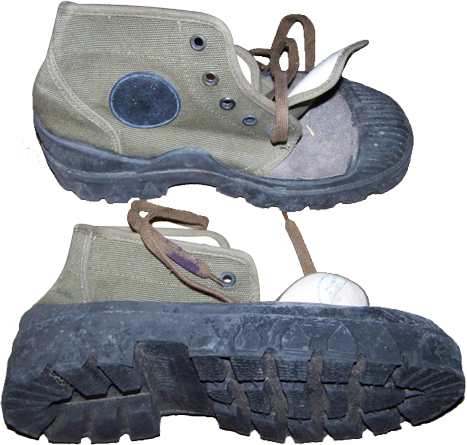
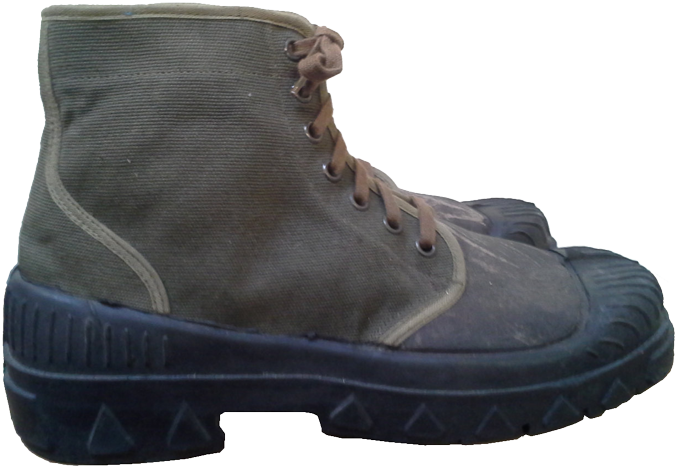
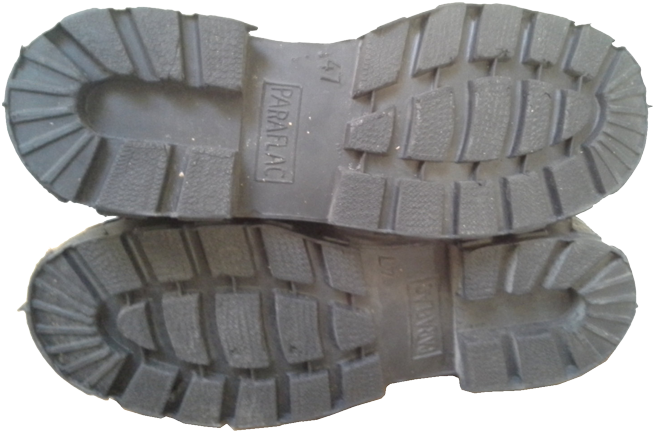
The boots by "Paraflac" recall the classic and the familiar "Converse"-type "keds"-like sneakers, they feature high and massive black rubber out-sole, which grasp the shanks almost like "galosh" rubbers, with an additional thickening at the inside shank of each boot, its own tread pattern and round protective rubber pads on the on the inner surfaces of top. The number of lacing eyelets was different, for example, 5 or 7. The removable insoles were made of woven hemp. They year of production (e.g. 1957) was ink-stamped on the inside. The sole had the indication of size and the manufacturer's name.
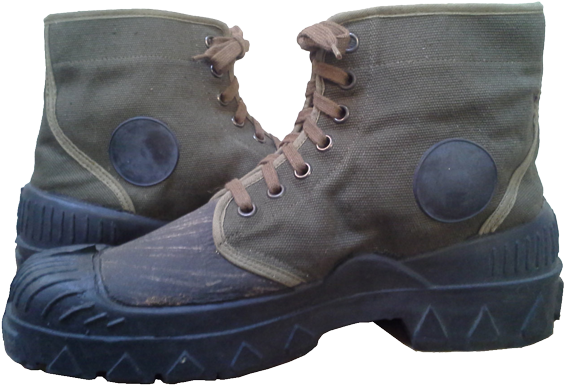
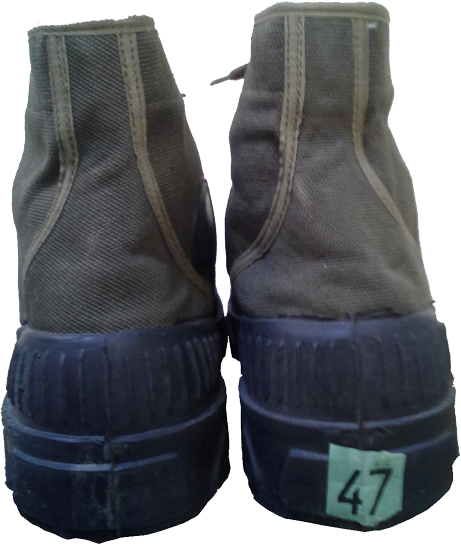
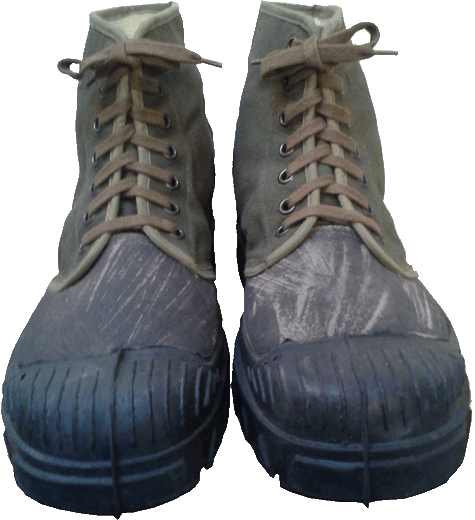
At the top of the "Paraflac" boots, from the toes to the bottom of lacing, the rubberized waterproof tarp was used to protect this area from moisture impregnation. Obviously, this measure reduces the ventilation inside the boots, and it is not surprising that the other manufacturers have not rushed to follow this idea - it still not ensured any serious protection from external moisture, but it was difficult to dry the sodden canvas boots of such type.
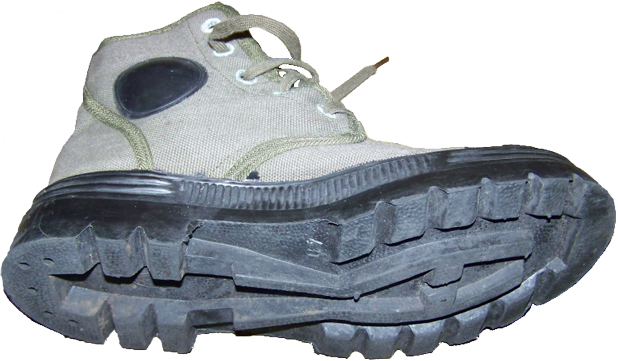
Nowadays one can find(relatively cheap, usually in French ebay) the original "Pataugas" on sale, in "mint" condition (mostly by production of "Vernon" or "Wissart"), but the vast majority of them are large sized, and the reason for that is very simple: only a very few soldiers had large size feet, plenty of bigger size boots have never been issued. Medium and small size boots, on the contrary, were widely used, and such lightweight boots used to wear out very quickly in the field. After about six months of use in the war time, for example, in Algeria, they began to fall apart, and that was the price for using those extremely lightweight and breathable boots.
Canvas boots by "Vernon" were one of the first to appear, and this company took active part in the development and testing of prototypes of "chaussures de brousse".
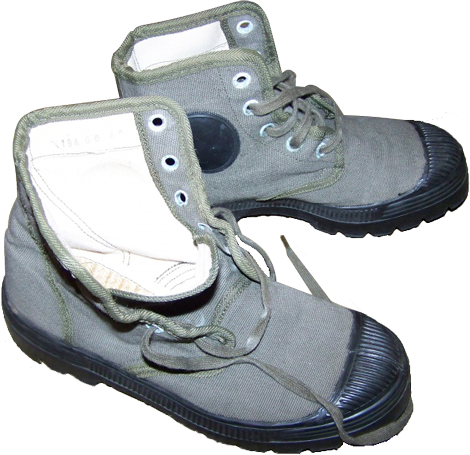
They do not differ radically from all the other canvas boots of the French armed forces, except for the design of the sole and the tread pattern: the edges of the soles feature the square-shaped lugs, in the center, starting from the heel and almost to the toes there are strong longitudinal lugs, and in the middle area of the out-sole there is a small ledge that makes the design more anatomically correct, and provides greater comfort when walking.
Among the currently marketed original "Pataugas" a significant part are made by "Wissart". This manufacturer used to make all existing versions of these canvas boots - high and low, with the cuffs and two buckles and without them, with black and green rubber out-soles, with different number of lacing eyelets, with green canvas top of various shades, from olive to the one, similar to the standard US Army color of tropical uniforms (OG-107 Tropical Combat Uniform jungle fatigues), which was used from 1952 to 1989.
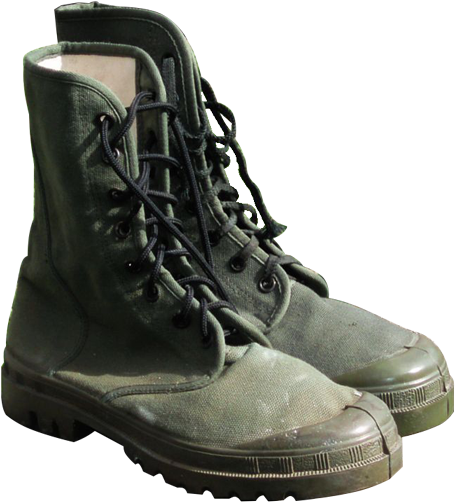
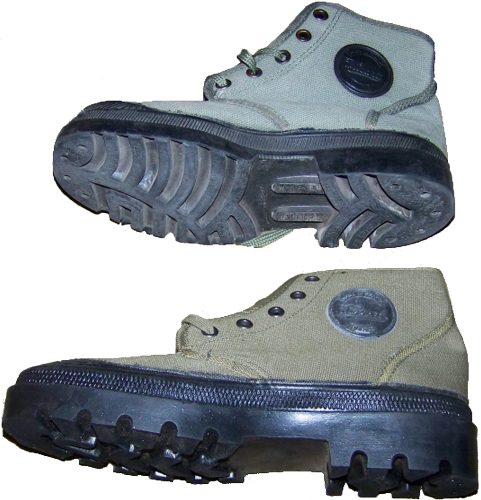

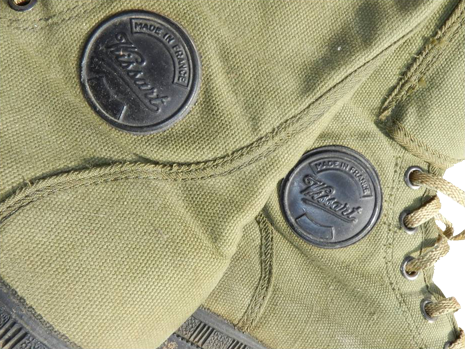

In order to protect the malleolus bones of the feet, the low "Pampa"-type boots featured round rubber pads, which very often were labeled with the name of the manufacturer, the country of manufacture ("Made in France"), sometimes the city of production, for example, "Paris".
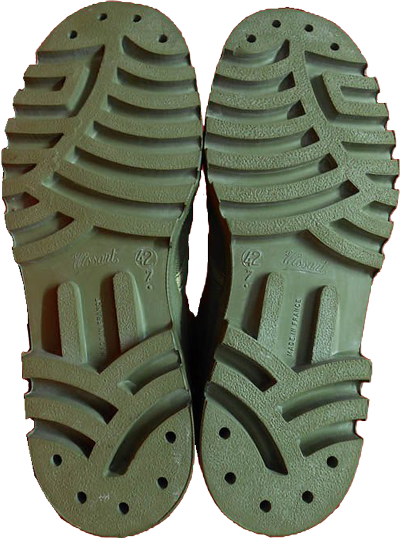
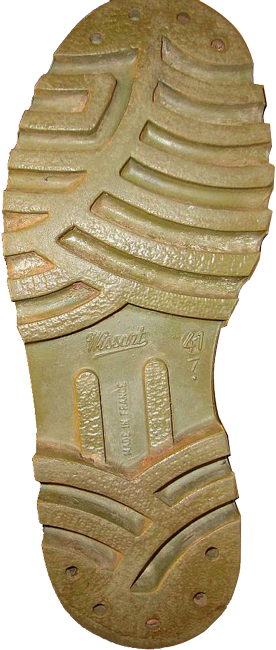
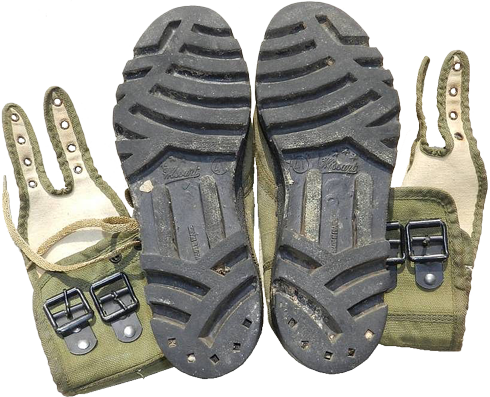
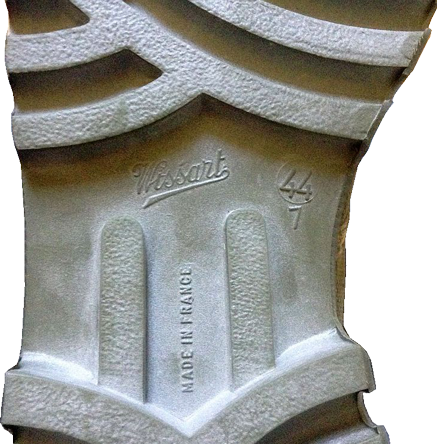
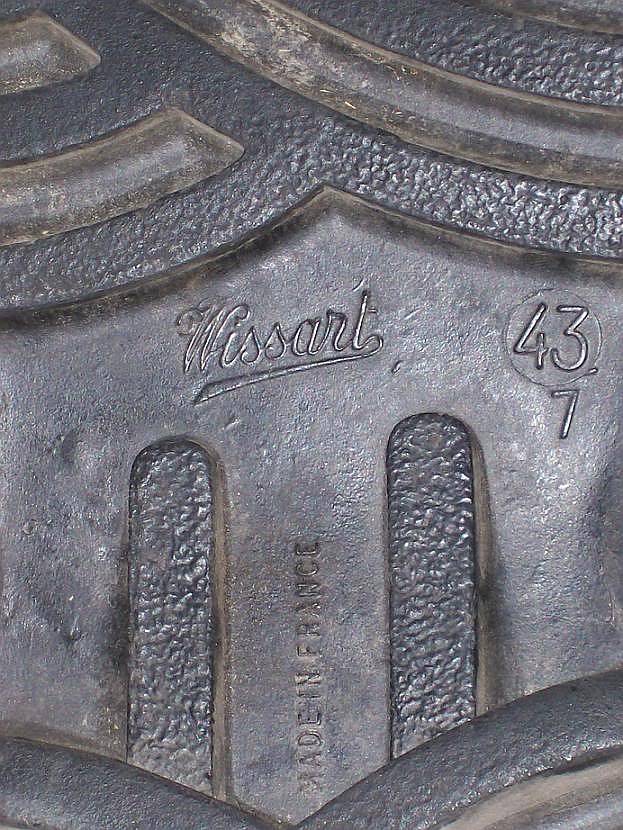
The out-soles tread patterns of most "Wissart" boots can be easily distinguished from all the others, as this patter represented by itself the composition of the parallel radial semi-arches resembling the frond. On a much smaller part of the boots there were some other tread patterns, resembling the pattern of more famous "Palladium" boots.

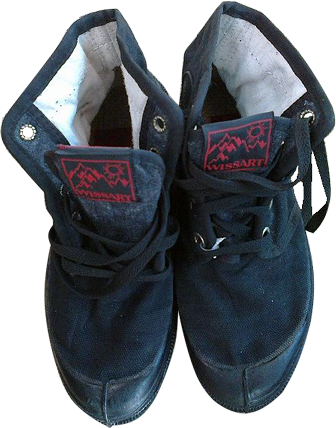
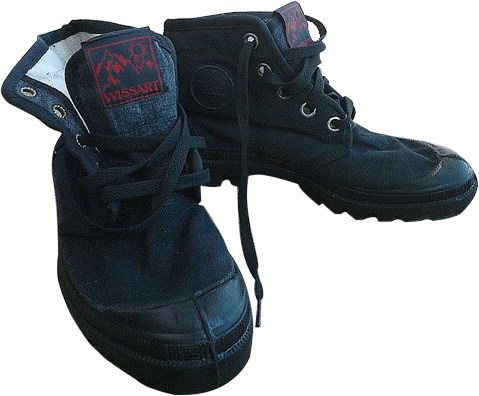
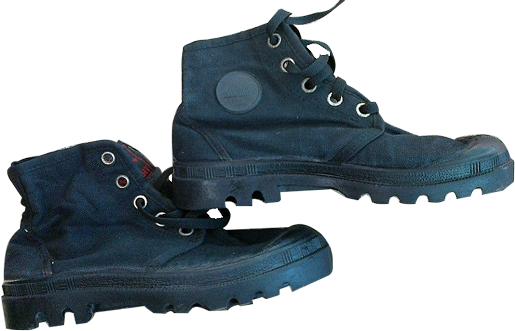
Today, one can find the modern version of those "Wissart" boots, quite similar to those made decades ago. For example, it is possible to buy black boots with black rubber out-soles, featuring five pairs of large aluminum lacing eyelets, round rubber pads on the inner shanks, with red stripes on the tongue and the inscriptions: "Wissart", "France", "Made in Pyrenees"...
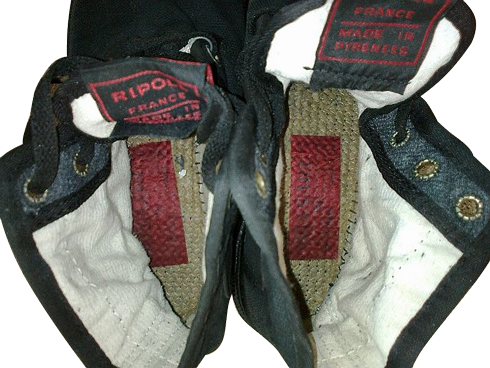
Even in the insole of these boots is the same as in the "good old" classic versions: from natural woven jute fibers, hygienic, quick-drying, comfortable to wear and care.
"Paul Boyé" was founded in 1904 by Pierre Boyé as a small tailoring workshop for men in the town of Sete, France. Now the company offers a complete range of products for military and medical personnel, fire-fighters and decontamination experts, military police and law enforcement teams, aircraft and helicopter pilots etc., to meet the strict requirements of Civil Defence and Armed Forces.
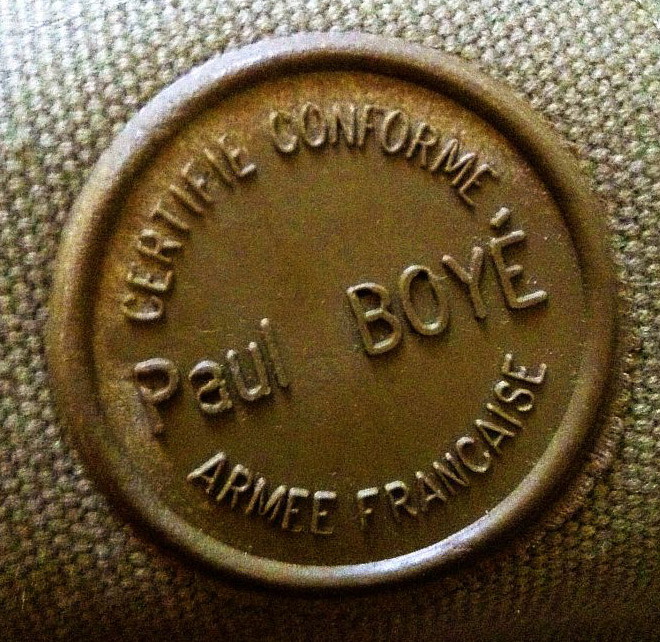
The periods of company's prosperity correspond to world wars. Thus, in 1914 the French Army took over the workshop to make blue uniform, in 1939 Paul Boyé got big "war order" for warfare type canvasing. In 1947 Paul Boyé opened "Manufacture de Vetements Paul Boyé" with three factories in France, and 13 years later the company became the main uniform supplier of the French Army. In 1976 the first big contract was signed to export uniforms to the U.A.E. Since 1978 launched the manufacture of CBRN suits in France, and in 2012 this French Company signed an exclusive contract with the Pentagon to manufacture Protective canvasing for the U.S. Armed Forces.

On the French-speaking web-forums, dedicated to various military boots, they also mention "Pataugas"-type canvas boots, produced, in particular, by "Bata".
One of the passionmilitaria.com members, Gantheret, wrote the following: "La première paire de "pataugas" que j'ai percue fin 1947 ou 1948 au II/6° RIC était de marque "BATA" fabriquée en TCHECOSLOVAQUIE...", i.e. "the first pair of "Rataugas" I saw at the end of the year 1947 or 1948, in the colonial infantry regiment II/6° RIC (where RIC (fr.) stands for "régiment d'infanterie coloniale"). These boots were marked with the "BATA" logo, and they were made in CZECHOSLOVAKIA...".
This info was supplemented by the forum member seb76: "Pour la marque Bata il ne s'agit pas de production communiste. La production Bata etant nationalisé en 45 une autre marque Bata coexistante avec la premiere est recrée par la famille Bata au Canada en 1946. En 1948 quand la Tchecoslovaquie devient communiste la marque Bata disparait devient "Svit".", that means "The Communists did not manufacture the boots under the brand name "Bata", because the company's manufacturing facilities were nationalized in 1945. At the same time there there existed two "Bata" brands, and the second one arose after the Bata family departure to Canada in 1946. In 1948, Czechoslovakia became a Communist state so the "Bata" brand disappeared, and a new independent "Svit" brand was founded instead".
seb 76: "Si il s'agit d'un reportage sur le coup de Prague en 48, a cette période la marque dépend de l'Etat Tchecoslovaque. En effet toutes les usines a l'est ont été nationalisées en 45. Mais il y avait d'autres sites de production a l'ouest dont Bataville. Les propriétaires ont donc conservé celle de l'ouest et sont partis au Canada. Même si la marque devient Canadienne, elle continue a produire en Europe de l'Ouest sur dans les usines existantes. ... mais il me parait plus logique que les Francais ont commandes des pataugas Bata (Canada) qui sont fabriquées en France, plutôt que des pataugas Bata fabriqués en Tchécoslovaquie entre 45 et 48, même si le gouvernement Tchèque a cette époque n'est pas encore communiste.."., i.e. "If to talk about the period of the power change in Prague in 1948, the "Bata" brand depended on the Czechoslovakian government. In fact, all the private-owned enterprises in the East were nationalized in 1945, but there were the other production sites in the West, for example, in Bataville. The owners, however, retained their production facilities in the West and moved to Canada. Even if the brand was owned by Canadians, the production process continued in West Europe at the existing factories .... it seems more logical that the French ordered "Rataugas" of the "Bata" brand from the Canadian owner, but the boots were made in France and not in the factories of Czechoslovakia, with its certainly communist government in 1945-1948...".
It is also worth to mention another canvas-rubber boots manufacturer, who produced an alternative type of "Pataugas" boots, to which this review is dedicated
This boots were produced by "Converse", which has done much for the development and promotion of light canvas boots with rubber out-soles.
"Converse" is an American footwear company, which was founded on February 1908, in Malden, Massachusetts, by a 47-years old businessman, Marquis Mills Converse, under the original name "Converse Rubber boot Company". It's production output primarily consists of sportswear and "All Star" brand footwear, they sell other items globally through approximately 75 company-owned retail stores across the U.S. and over 160 countries of the world. The company started manufacturing of rubber and canvas boots several decades earlier than any other producer.
In 1915 the company began manufacturing athletic boots for tennis, and in 1917 the "Converse" "All-Star" basketball boot was introduced.
Next time the canvas-rubber boots became popular in the 1980s as casual footwear, but "Converse" eventually became over-dependent on its single "All Stars" brand, whose market collapsed by the years 1989-1990 when America faced economic depression and the market environment was getting more and more competitive. On January 22, 2001 the combination of circumstances, market share loss and unwise business decisions, forced Converse to file for bankruptcy.
In July 2003 "Converse" was purchased by "Nike, Inc." for $309 million US dollars as a subsidiary company, having preserved the manufacturing of its products under the "One Star", "Jack Purcell" and "Chuck Taylor All Star" trade names. Now "Converse" sells its products in more than 160 countries of the world and through approximately 75 company-owned retail stores across the U.S.
During the war in Algeria, "Converse" boots were popular with Algerian FLN (Front de Libération Nationale), along with Chinese-made "Pataugas". These lightweight and practical boots were also popular with the French colonial forces for wear both in-garrison and off duty, as well as for boot camp-type activities.
As opposed to any other footwear with hard out-sole, lightweight, comfortable and durable "Pataugas"- type boots made of canvas and rubber, allow one to feel much better the ground before putting full body weight on it. This makes such boots very suitable for sneaky going on rugged terrain. According to customer's feeling these boots are similar to modern day moccasin, however "Pataugas" do not stretch when wet.
However, these inexpensive and very lightweight "scouting boots" do have a down side, which is the consequence of the advantages. The out-soles are so flexible, that they simply are not stiff to give enough arch support and feet protection against sharp objects like tree thorns, which can cut through the soles without even minimum resistance.
Special thanks to Jean. L for this information and photos:
In the picture one can see the carton box of Pataugas boots, made by "Bonusage" in 1961.

A label sticker is attached on the one face of the box, showing the name "Chaussures de brousse", the size (46) and the number of the pairs (10) inside, representing by itself the packaging and checking report done for the Pataugas in the box in the year 1977, and a serial number for tracking.

Inside the box, there was a report indicating the army base (depot): "Dépôt d'habillement de Châtres" (Châtres is located in the French département of Aube) with 2 signatures, one from the soldier which has done packaging/check (the left one) at one other (the right one) from his "supervisor" for official approval.
The size "46" is hand written over the originally printed stamp, because with the sunlight and time, the original ink faded out.

Below you can see the Pataugas boots made by Palladium.
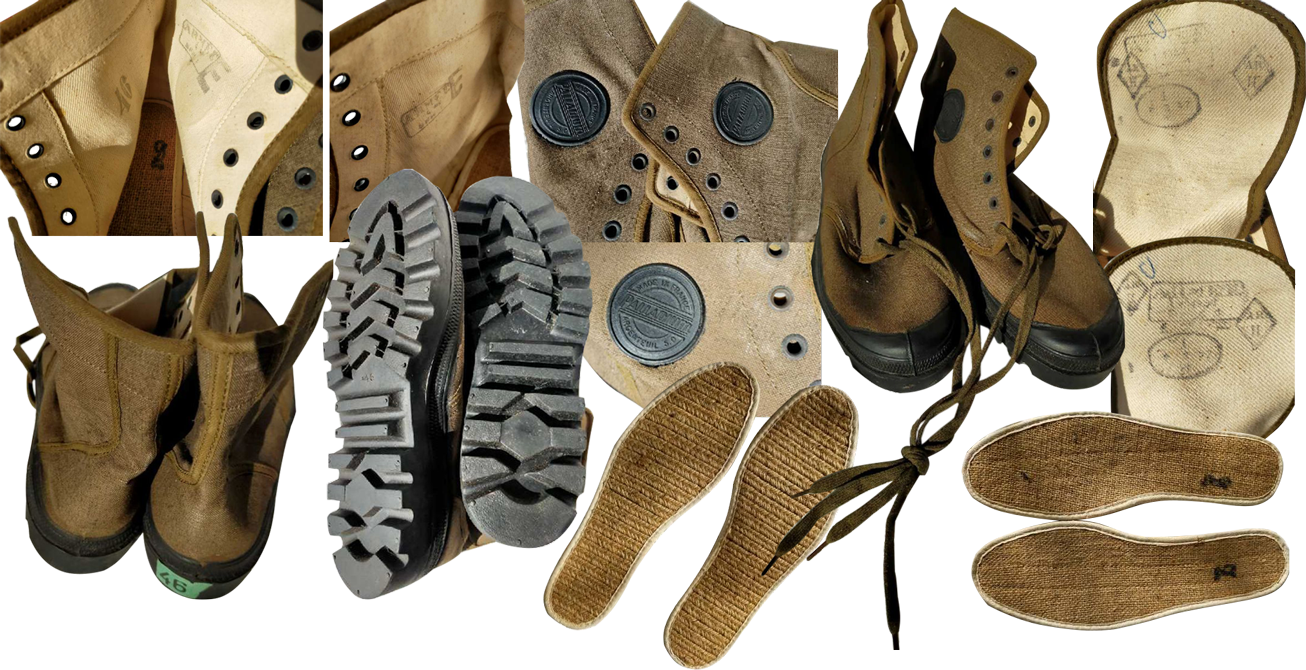
Sources of images and data:
http://www.monbottier.fr/marques/pataugas
http://www.passionmilitaria.com
https://www.etsy.com
http://frenchindochinawar.proboards.com
http://styleforum.ru
http://www.monbottier.fr
http://shopotam.ru
http://www.lexpress.fr
https://fr.wikipedia.org
http://www.use.com
http://fr.1001mags.com
http://www.delcampe.net
http://www.warrelics.eu/forum
http://wehrmacht-awards.com/Forums
http://spijkerstof.blogspot.com
http://www.ebay.com
http://feraljundi.com
PHOTOS : Alain Bruschi et Clément Favre Tissot
Exclusively for cartalana.com
We have much more interesting information on this site.
Click MENU to check it out!
∎ cartalana.com© 2009-2025 ∎ mailto: cartalana@cartalana.com